#it becomes the most successful haunted house in the usa
Text
Danny decides to open a haunted house for Halloween-in Gotham. For kicks. He reserves the opening night for the Bats and only the Bats. The Bats do not have a choice in this.
They all wake up in the haunted house.
Their rogues, who had big plans, also wake up in the haunted house-but they don't get the toned down spooky version Danny's working on for potential customers that he's doing a test-run with via Bat testers.
No, the Rogues are locked in the basement with the ghosts of everyone they've killed.
Danny's got Tucker running the cameras, Sam helping coordinate the Ghosts, and Danny himself is running the actual spooky bits.
In theory, it's the perfect haunted house.
The best way to test it though, he feels, is against heroes that face scary things every day.
So.
Red Hood walking down a hallway, sees feet dangling from the ceiling. But there's a convenient beam blocking their view, so he strides up just as the feet vanish-and that's a solid wooden ceiling.
There's a note with a smiley face.
"Please rate your haunting experience on a scale of one to ten! :)"
Robin sees a shadow, and he chases it. And chases it. And chases it. And foolishly he somehow manages to let it lead him to a dead end-only when he turns around, the shadow is in the door.
And it's just a being made of pure shadow, with elongated limbs, breathing with a horrible wet rasp as it stares down at him.
Then it disappears.
In it's place, there's a note.
"Please rate your haunting experience on a scale of one to ten! :)"
Red Robin hears Batman call out for him to look something over, so he goes into the room.
Batman isn't there.
Batman's voice whispers in his ear from behind.
"Never thought you'd fall for that~"
The door slams shut.
Red Robin turns to open it, but it won't open. Not even if he picks the lock.
The floor creaks, and when he turns around he sees Batman standing right there-only for him to dissolve piece by piece.
In the puddle of weird green goo, there's a note.
"Please rate your haunting experience on a scale of one to ten! :)"
Bruce is in what looks like a child's room.
The temperature drops, and he braces for a supernatural event, because this is clearly what's going on.
The air stands still-and every single toy's head snaps to look at him.
They open their mouths and scream, green goo gargling up and spilling out of their lips.
The lights cut out, then they come back on; and the toys are all arranged around him in a peculiar pattern.
There's a note at his feet.
His lips quirk up against his will.
"Please rate your haunting experience on a scale of one to ten! :)"
Nightwing knows he's being fucked with.
He knows it.
He recognizes the room he's in-it was in the pamphlet for the new haunted house opening in Gotham. He'd really wanted to go, actually, but he was kinda sad he didn't have anyone with him.
He wanted it to be a family outing.
But from what it looks like, this is probably a test run. No ones emergency beacons have gone off, and there's only swearing in the comms cut through with mild amusement on Bruce's part.
Ugh, he doesn't want spoilers! He wants to go through it for the first time with everyone else!
"Hey, um, I was actually planning to come here with my family! I don't really want to be spoiled on anything, so can I skip this? And can I have anyone you haven't tested it on skip it too? Cuz they're probably friends or family and I want to be on the same knowledge level of what to expect."
The air itself seems to pause.
"Ah, shit, I'm sorry man. I didn't even think of that; I'll pull Spoiler and Signal before we start their runs."
Nightwing turns towards the intercom and waves cheerfully.
"I mean, we'd definitely be down to walk through the house tonight, but I want to do it in a group so we can laugh at each other."
"Oh, for sure, I just got too caught up in the 'creepy' part of the haunted house. The exit is hidden in the wall to your left, just pick up the rotary phone and it should pop out."
"Alright, I'll be waiting for them at the front!"
@simplestoryteller
#dpxdc#dcxdp#dp x dc#dc x dp#story prompt#phanfic#danny and co own and run a year-long haunted house in gotham#rogues are afraid to go anywhere near it#it becomes the most successful haunted house in the usa#it actually creates a tourism factor for gotham besides people wanting to see the “most crime ridden city ever”#danny and dick get along great#and after things settle he works with the bats (without knowing their civvie identities) to make it better#bruce is highly amused by the whole thing#the fact that during halloween it's basically gotham rogue daycare really helps with that#long post#ficlet
2K notes
·
View notes
Text
We Remember: When 9/11 Forged a Genuinely United States of America

Today, we remember.
We remember that the weather was perfect throughout nearly the entire country on that Tuesday morning. We remember where we were when we heard about the first plane hitting the tower. We remember what we thought as the new just began to trickle in. We remember our horror as we watched the second plane hit the South tower. We remember the evacuations -- people running out of our monuments of freedom and democracy, our centers of government and finance, and spilling out on to the streets of our nation’s capital. We remember the dust and debris chasing thousands of New Yorkers through the streets of our most iconic city. We remember the smoke rising from the Pentagon. We remember that impact site in Pennsylvania -- a smoldering hole in an empty field instead of the rotunda of the U.S. Capitol building because Americans decided to fight back. We remember watching the towers fall.
We remember the fear, the chaos, the sadness, and the feeling of not knowing what was happening or when it would end. We remember a feeling that Americans were not used to experiencing up to September 11, 2001: the helpless feeling of being attacked as went about our normal lives. We no longer remember what it felt like on September 10th.
Do you remember pointing fingers? Do remember placing blame? Do you remember partisanship? I remember patriotism. Not bumper sticker and window decals. Genuine patriotism. I remember flags and candles and donating water and giving blood and having a new appreciation for first responders. I remember that, for at least one week, we weren’t Democrats or Republicans. I remember that we were Americans. I remember that we cared a little bit more about each other for at least a couple of weeks.
When Democrat Lyndon Johnson was the Senate Majority Leader and Republican Dwight Eisenhower was President of the United States, LBJ -- one of the most intense, passionate, partisan political animals in our history -- never attacked President Eisenhower. It wasn’t because LBJ agreed with Eisenhower’s policies. It wasn’t because LBJ was scared. It was because, as LBJ explained in 1953 in a comment that has an unfortunately haunting connection to 9/11, “If you’re in an airplane, and you’re flying somewhere, you don’t run up to the cockpit and attack the pilot. Mr. Eisenhower is the only President we’ve got.”
The only President we’ve got.
We all want to head in the same direction. We all want to move forward. We all want to progress and be happy and healthy and safe. But now, more than ever, our country’s prosperity is crippled by divisive partisanship. As World War I and World War II approached and the world realized that we are clearly connected on a global level, the people who seemed the most out-of-touch -- the people who were wrong -- were the isolationists. In both of those great wars, the isolationists were proven wrong. Yet, in the span of our grandparents’ lives we have regressed to the point where most Americans have become individual isolationists -- not isolationism on a national level, but on a personal level. We’ve tried to disconnect from the people in our own country -- especially if they look, love, or think differently than us. Don’t you remember how powerful it felt after 9/11 to be united? Don’t you remember how we helped each other in so many different ways?
I guess I could be cynical. I guess I could remember the look on President George W. Bush’s face when his Chief of Staff, Andrew Card, whispered news of the attacks in the President’s ear as he sat in a Florida classroom. I guess I could remember The Pet Goat, and the fact that Bush didn’t immediately get up, sprint from the room, and change out of his Clark Kent clothes into the Superman suit. I guess I could remember Air Force One zig-zagging across the country, the only plane in the air besides military escorts and combat air patrols over our major cities. I guess I could remember the surveillance videos of the well-dressed hijackers walking through airport terminals that morning before they turned our planes into weapons. I guess I could remember that the passengers of Flight 93 didn’t actually get through the cockpit door and force the plane to crash into that Pennsylvania field. I guess I could remember our government’s alphabet agencies -- the FBI, CIA, NSA, and everyone else listening in on our world -- being unable to work together and stop the attacks from happening in the first place. I guess I could choose to remember those things, but that doesn’t make me feel better. It doesn’t make 9/11 anything but a success to those who tried to frighten and frustrate and intimidate us through terrorism.
This is what I choose to remember:
I remember that the passengers of Flight 93 tried to get into that cockpit. I remember that their plane didn’t make it to Washington, D.C., and even if they never actually breached the cockpit and physically forced the plane into that meadow in Pennsylvania themselves, they certainly fought back and forced the hijackers to abort the mission that they had planned. That plane didn’t crash into the White House or the Capitol, and that’s not because the hijackers got lost.
I remember driving to the wedding rehearsal for two of my best friends on the Friday after the attacks, feeling bad for them that they were getting married in the shadow of 9/11. I remember being amazed at thousands of people in the streets of Sacramento -- neighborhood after neighborhood, thousands of miles away from any of the attack sites -- holding a candlelight vigil. I remember that it was then, as I drove through the silence of these peaceful vigils, with flags and flames and tears all around me, that I thought, “We’re going to be okay.”
I remember George W. Bush -- a President I never voted for -- who, like all of us, was a bit unsteady with his words in the hours immediately following the attacks as he processed the magnitude of what we were living through. But I remember how he found his footing and found his voice quickly and began to speak for all of us. I remember him returning to Washington, D.C. that night, against the wishes of his government and his Secret Service protection. I remember how this President -- a President I didn’t agree with, a President I never cast a supportive ballot for or whose campaign I ever donated a cent to, a President whose beliefs were diametrically opposed to almost everything that I believe in -- went to Ground Zero and met with the families of those who were dead or missing, and gave them all the time they needed with him.
I remember how that President visited the rescue workers at Ground Zero. I remember, more than anything else, how President Bush climbed on to a pile of rubble from the fallen towers of the World Trade Center, grabbed a bullhorn and began to speak, but was interrupted by the workers yelling, “We can’t hear you!”
I remember that the President -- the only President we had at the time -- shouted to these exhausted, weary, grieving, heroic rescuers, “Well, I can hear you! And the people who knocked these buildings down are gonna hear from all of us soon!” I remember that it was genuine, that there was nothing manufactured about that moment, and that, despite all of his faults and deficiencies, George W. Bush said exactly what those people -- our people -- needed to hear. As the workers chanted, “USA! USA! USA!”, I remember thinking that I didn’t vote for him and I won’t vote for him in 2004, but at that moment he was my President and I was proud of him.
As we look back, we can’t help but think about everything else that has come out of 9/11 -- the interminable war in Afghanistan, the unjust and unnecessary war in Iraq, the humiliating and annoying experience that flying in an airplane became in this country -- but I think about that stuff pretty much every day, and I feel like this should always be a day where we think differently.
So, even if it’s just for this day, I’m going to think about those flags and candles and President Bush on top of the rubble of the World Trade Center with a bullhorn. I’m going to think about being an American -- just like I was in the weeks following 9/11 -- rather than who I voted for or what team I like or any of the millions of things that divide us and can get back to tearing us apart tomorrow like they did yesterday.
I’m going to remember thinking, “That’s my President,” as President Bush spoke to the rescue workers, just as I did a few weeks later when he went to Yankee Stadium for Game 3 of the World Series, strapped on a bulky bulletproof vest under his FDNY jacket, walked to the pitcher’s mound, and with millions of Americans watching on television, with thousands of rabid New Yorkers watching in the stands, and with Derek Jeter’s words of warning (”Don’t bounce it or they’ll boo you”) rattling around in his head, threw a perfect strike.
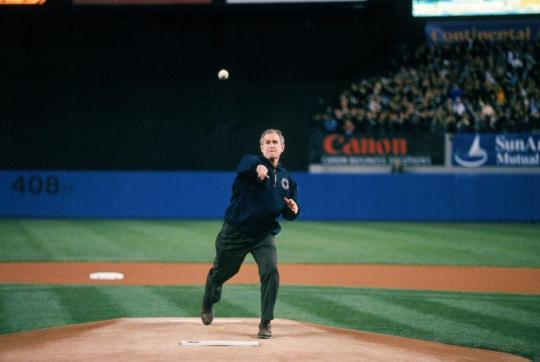
I’ll remember thinking, “That’s my President,” about a guy I never voted for and didn’t agree with, and I’ll hope that you do that when the guy you didn’t vote for and didn’t agree with says the right words, does the right things, and throws a strike when our nation needs it -- not because you’re a Democrat or a Republican, but because you’re an American and that’s the only President we’ve got. We don’t have to disagree about everything just because we don’t agree about most things, and we don’t have to like everything about one another to understand that, sometimes, we need each other.
What do you remember?
#September 11th#9/11#September 11th Attacks#History#Personal#Politics#Americans#20th Anniversary of 9/11#Never Forget#Never Forgot#I Remember#We Remember#George W. Bush#President Bush#Bush 43
145 notes
·
View notes
Text
Tracking the steps of the Deer Dancer

Some years ago, in Southern Arizona, a friend advised me to beware of the desert's spiky plant life. Sure enough, wandering the zigzagging paths through the canyon, I found myself picking fine spines from my clothes and skin. Learning to minimise this risk, I started paying attention to the ground and noticed human trails intersecting with animal tracks – javelina, coyote, and especially deer. With no rain for weeks, hoofprints remained debossed in the dry earth, like chains of split hearts, or strings of letters. Where clusters of tracks had accumulated, it looked as if the deer had been dancing.
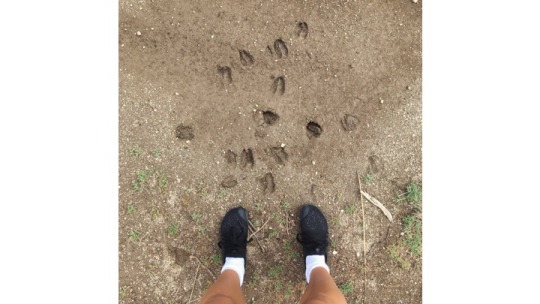
During that same visit, I came across a copy of the book Yaqui Deer Songs / Maso Bwikam: A Native American Poetry, edited by Larry Evers and Felipe S. Molina. Originally from the Río Yaqui, the indigenous Yaqui (or Yoeme) people now reside across the divided borderlands of Sonora, Mexico and Arizona, USA. I read that before setting out to hunt, their ancestors held a festive rite, enacting the wilderness world through a series of songs that address the deer, asking forgiveness for those animals that will die. Though hunting is rarely practised by present-day Yaqui, traces of the tradition remain extant in the Deer Dance, wherea single male dancer becomes the Maaso– the deer – and, wearing a stag headdress, he imitates the movements of a white-tailed deer.
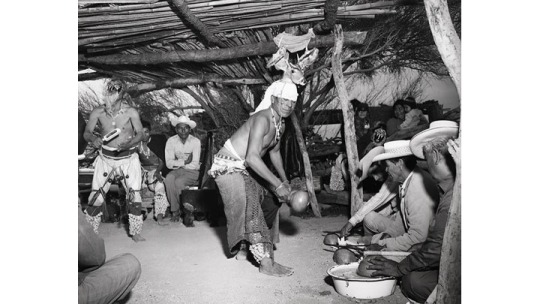
I was struck by the ways in which the photos of the costume bore a resemblance to some images I'd seen of the antlered headdresses found at Star Carr, a Mesolithic site in Yorkshire. Archaeologists have suggested that these red deer frontletswere worn in hunting rituals, allowing the wearer to harness antler effects, gaining access to the perspective of the 'animal-in-action'. Could this also be true for the Yaqui Deer Dance?
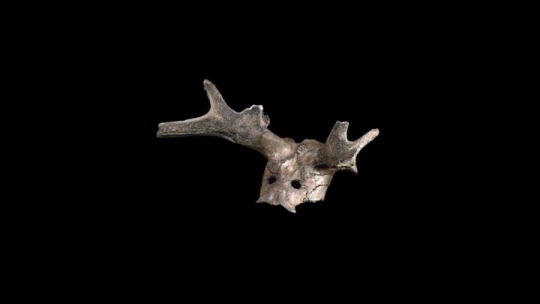
Pondering these connections, I recalled two dances I'd heard about in the British Isles – the Abbots Bromley Horn Dance of Staffordshire, believed to be a memory of a celebration of villagers’ hunting rights, featuringsix men bearing mounted antlers said to move like deer, and the Scottish Highland Fling, thought by some to have its origins in a warrior’s dance imitative of deer, with hands held aloft for antlers.
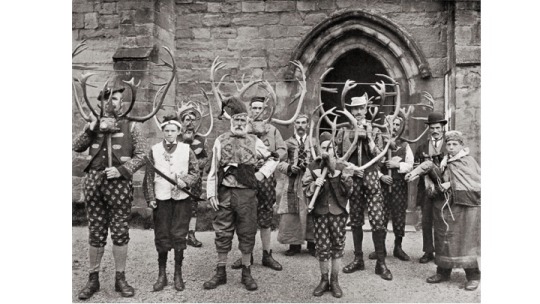
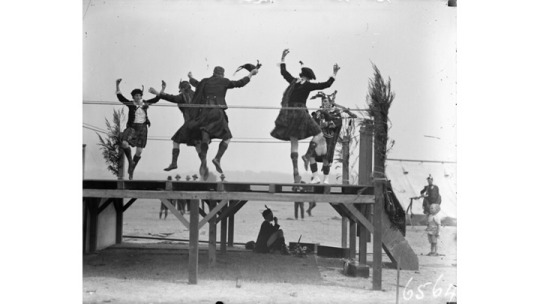
'Mimesis' – the imitation or emulation of the more-than-human-world – in traditional music and dance is something I've explored over the years, from Scottish Gaelic vocal imitations of birds, to the practice of embodying a river in South Indian Kutiyattam movement. I was keen to find out more and studythese three'deer dances' in tandem.What kind of deer effects are harnessed in these dances? Which deer behaviours are imitated and why? What do they reveal about our relationship with deer and ecology?
Over the next couple of years, I made numerous field trips to observe dances, interview practitioners, and learn steps directly from tradition bearers. Spending time observing deer, I consideredthe ways in which their behaviour is emulated in the dances and, learning about the ecologies of their habitats, I examined their relationship to hunting, stalking at Trees for Liferewilding estate in Dundreggan, and animal tracking in the Sonoran Desert. I was particularly interested in exploring the 'tacit' knowledge embodied in the dances. What could be discovered by 'learning' and 'doing' these dances, as opposed to just 'watching' them? What could be discovered in the body, through practices of stalking and tracking, instead of simply 'reading' about them?
Needwood Forest, Staffordshire...
I first went to see the Abbots Bromley Horn Dancein September 2017, and then again in 2018. This folk dance takes place once a year in the Abbots Bromley village, near to Bagot's Wood, an area of woodland just one and a half square miles, which is all that remains of the ancientNeedwood Forest. Like most forest in Britain, historically it was property of the Crown and, in this case, was once parcel of the Duchy of Lancaster.

Today the word 'forest' refers to an area of wooded land, but the medieval sense of the word referred to land set aside for royal hunting. The 'Royal Forest' included large areas of heath, grassland and wetland, essentially anywhere that supported deer and other game.Villages and towns that lay within it were subject to forest law, protecting the 'Beasts of the Chase' from being hunted by anyone except the king, safeguarding the habitat in which they lived. These 'beasts' were primarily deer, and included native red and roe deer, as well as non-native species such as fallow deer, introduced to England for the very purpose of hunting.
Every Royal Forest in England was overseen by a keeper who was appointed by the King, and whose position was often hereditary. Forest Law meant that it was illegal to hunt deer, chop down trees or underwood, unless permission had been given by the Crown. Penalties for offenses were severe, but by 1217, the death penalty for poaching had been abolished. This didn't stop some kings; during the reign of Henry VIII, a yeoman named Richard Horne was caught poaching deer in the woods and was hung for his crimes. His ghost, known as Herne the Hunteris said to haunt Windsor Forest, with antlers growing from his head and chains rattling behind him.
Within the structures of Forest Law, payment for access to certain rights became a useful source of income and local nobles could be granted a licence to hunt an agreed amount of game, giving forest inhabitants a variety of rights. As I mentioned, theAbbots Bromley Horn Danceis believed by some to be a memory of a medieval celebration of villagers’ hunting rights, possibly recalling the act of giving thanks to the local nobility for access to the Royal Forest. Others believe it was danced to ensure a successful hunt, or a good harvest. The forest itself was largely lost in the eighteenth-century due to deforestation. With all this in mind, I couldn't help but think that the Horn Dance was taking place in an imaginary landscape, in the ghost of a place that no longer exists.

The dance itself featuresten dancers: six deer-men carrying mounted antlers, a hobby horse, bow-man with his bow and arrow, Maid Marian (or man-woman) with their stick and ladle, and the fool with his pig's bladder. The antlers are mounted onto carved wooden deer heads at the end of sticks, reminiscent of a child's hobby horse toy. Surprisingly the antlers are not native; carbon dated to 1065, they came from reindeer, long extinct in Britain.
At eight in the morning, after collecting the horns from the church, the ritual begins. Moving in procession, the horn dancers exit the church yard and, on a street corner in the village, they perform a sequence of steps, circling and winding in time with the accompanying music performed on melodeon and triangle. Though stylized, particular movements are especially mimetic. Recalling the rutting behaviour of a number of species of deer, the dancers move together in a parallel walk, and then face one another, moving towards and away, passing through, as if clashing antlers during a fight. Followed by villagers and visitors alike, the horn dancers and their musicians proceed to beat the bounds of the village, walking over ten miles throughout the day, performing at each farm and pub. Taking a drink at every stop, as you might imagine, banter follows, with jokes erupting at every turn. The music is constant and consistent and, soon enough, I found myself humming along with the tunes. The sound of the triangle was particularly affecting, cutting through the cacophony of sound.

At Blithfield Hall, the tone changes considerably. The hall, a Grade 1 listed country house owned by the Baggots, has been in the family since the 14th century. The horn dancers perform on the lawn outside and when the music stops, they stand in line and wait. The Lord and Lady of the house then proceed to shake each dancer's hand, while the audience looks on from across the boundary wall. In a legacy of class inequalities, the memory of a celebration of hunting rights becomes particularly visible. Back in the village, the dancing finishes at about eight pm, when the horns are returned to the church, to be hung on display until the following year.
During the dance, I met Jack Brown, a tradition bearer and local historian, now in his nineties, who was dressed as a fool in yellow tails. He explained that he had "played all the adult parts" in the Abbots Bromley Horn Dance – deer, hobby horse, fool, man-woman and musician – and invited me to visit him at his home, a treasure trove of photos and objects, including props from the dance – a pig's bladder, triangle, bow and arrow, and stick and ladle. Jack shared with me his memories and knowledge of the dance's history and gifted me a pamphlet on his interpretation of it.
The horn dancers themselves are also very generous, opening up the floor – or ground – to participation, and over the two years I visited, I took part in a number of dances, giving me direct insight into the movements, shapes and step formations, as well as an embodied understanding of the sheer weight of the horns. Weighing between sixteen and twenty-five pounds, it is physically difficult to dance with these objects, to carry and move with them. Reindeer antlers are larger than red deer – our biggest native species – and if, as it has been suggested, they were imported from Scandinavia, perhaps we could say that the dancers of yesteryear were attracted to their size, in order to 'harness their effects'. What are these effects, I wondered? The size and weight of the antlers certainly enhances a performance of physical strength, perhaps showcasing 'heroic' abilities of endurance. During times when hunting was commonly practiced, these were presumably important attributes.
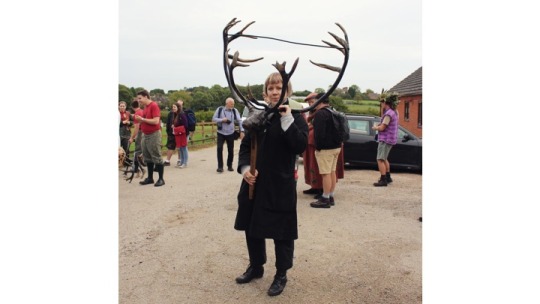
The props are most deer-like during the 'fighting sequence' when the antlers become like weapons between three pairs of rutting deer-men, albeit in an incredibly stylized rut. Some folklorists have posited that the Horn Dance was a fertility ritual; the antlers in this case would be symbolic of the male sex organ. Was this a mimetic display of the stag's bravado? Certainly, at some point, multiple powerful effects were being harnessed.
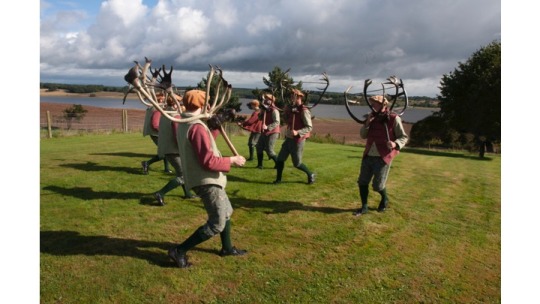
Back in the studio, I began to make sketches, tracking the shapes made on the ground by the dancers in a series of visual scores. Returning the following year, I showed my score sketches to Jack, and to Jim, a deer dancer whose family, the Fowells, have been performing the Horn Dance since 1914 after it passed to them from the Bentleys – interestingly, the Bentley family were historically the foresters of the local woodland. Checking the shapes and patterns on the page, Jack and Jim approved my visual notations, confirming their accuracy.
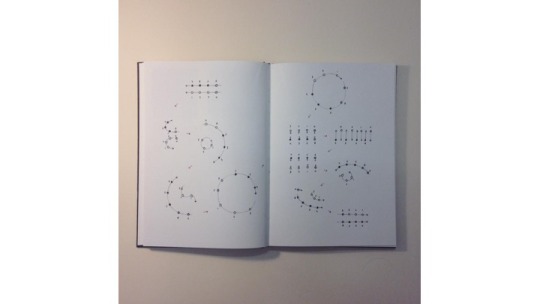
My notation process was also supported by a surprisingly fortunate booking! Reserving a room in a local B&B that looked down onto the area of the final dance, I was able to film it from above and compare the footage with my scores.
Caledonian Forest, Scotland...
The Caledonian Forest, characterised by Scots Pine trees, was once a huge forest stretching across Scotland. About 6,000 years ago, as the climate became wetter, some of the forest began to disappear, but the impact of human beings was even greater; trees were felled for ships, buildings, fuel, and to make way for agriculture. By the 1700s, the Caledonian Forest remained only in the most remote places and much of the wildlife that depended on this habitat was lost through hunting, or simply because there was not enough forest left. The last wolf is said to have been shot in Scotland in 1743, which meant that by this point, all of the predators had been wiped out. In fact, all of the largeanimals had gone, leaving only the red deer. Since then, this animal has come to symbolise the Highlands.
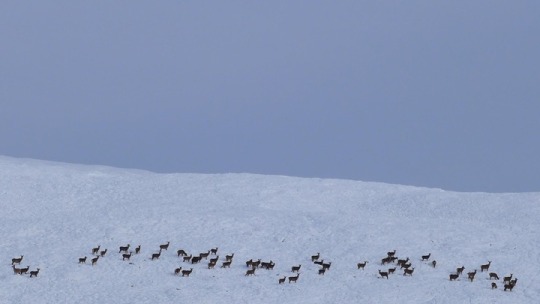
In the 19th century, as deer stalking became fashionable, large tracts of land were dedicated to deer, allowing their numbers to increase, and ‘deer forests’, which are essentially open hills managed for deer, doubled in size. Today, many Highland estates still maintain large deer populations for stalking purposes and the current number is estimated to be 350,000 individuals. Through their excessive numbers and overgrazing, deer are often seen as the problem that prevents the regeneration of the Caledonian Pinewood, however, the ecological imbalance between native forest cover, numbers of grazing deer and lack of natural predators has been caused by humans, not deer.
Trees for Life acquired their Dundreggan estate in 2008, and since then, they have been rewilding the land, planting new trees in places, such as higher mountainous areas where it is difficult for trees to establish on their own, and reducing grazing pressure to allow the forest to recover and regenerate, which, inevitably, involves the culling of deer. In 2017, I went to stay in Dundreggan, and went out stalking with Allan Common, the lead deer stalker on the estate. It was autumn, which in the red deer calendar, meant this was the time of the rut. Meanwhile in the stalking calendar, it was the time for hunting stags. I wasn't sure whether this seasonal stalking tradition was due to the fact that a rutting stag, full of high levels of testosterone, was less alert and easier to hunt, or whether it was because this hormone surge meant that the stag was now adorned with a large mane and antlers, and so more desirable as a trophy. Doug Gilbert, the operations manager at Trees for LifeDundreggan suggested that perhaps it was a mixture of the two – a legacy from the stalking craze.

Dressed in a ritual costume of wax jacket, gaiters and tweed deerstalker hat, at 7am I was met by Allan and two of his friends. Up on the hill, he instructed us to move as one body, then, as we got closer to the deer, he showed us how to lie on our bellies and remain hidden. At the edge of a ridge, we stopped to look down into a bowl-shaped area. The distant sound of roaring stags reverberated into the cold morning and, for a brief moment, through binoculars, I watched as two mature stags walked in parallel, checking each other out, before lowering their antlers, initiating contact. Throughout the morning, Allan, or one of his friends, would position a gun, then using its view finder, take a shot. Sometimes this awkward movement alerted the deer to our presence, so to counter this, Allan skilfully mimicked the bellow of the stag with his voice, to keep the stags interested. It worked! – at one point, a mature male drew very close, standing only a metre or so away. Concealed safely behind a boulder we listened to his spine-tingling roar. My heart beat fast.
While staying with Doug and his partner Joyce, a fundraiser at Trees for Life, I learned more about their work. In order to regenerate the Forest, as well as the practical task of planting trees, they explained that there needed to be a shift in values, from "seeing the land as a place for deer, to seeing the land as a place with deer in it". On the estate, it does feel as though this is happening. When I asked Allan what the biggest changes have been in his job as a stalker, he explained that it was his shift in perception; he used to think the deer were the most important thing, but now he values the land in itself, the ecology as a whole. He told me about an earlier job, working for a sporting agency, where people pay money to go shooting, but had realised some time ago, that he didn't like this 'trophy culture'. He preferred instead to have a relationship with the place, and recounted lying on his back, watching as a golden eagle flew over him, just metres above his body. His most treasured memories were not to do with stalking itself, but a connection with the more-than-human world.
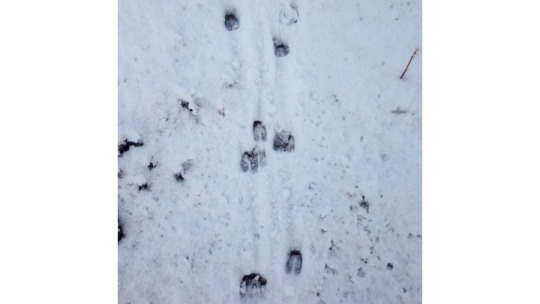
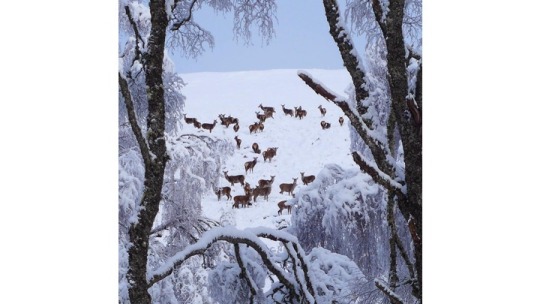
In February, when I returned to Dundreggan, there was heavy snow on the ground, and the deer tracks looked as though they had been debossed, not in earth but in thick white paper. It was the season for stalking red deer hinds, which, like the stags, were hunted in the morning. Night time was reserved for stalking the sika deer, an 'invasive' species from Japan. Being nocturnal, with a tendency to stay hidden under tree cover, they were difficult to spot. Allan used a combination of traditional tracking and an infrared thermal camera to find them. I began to reflect on the relationship of technology to the traditional costumes worn in the various dances, specifically in relation to the red deer frontlets found at Star Carr. Archaeologist Chantal Conneller has posited that these frontlets extended the body of the wearer, allowing them to "harness the animal in action", expanding their perception, essentially becoming-with-deer in order to hunt them. The user of the hunting rifle, with telescopic view finder and infrared thermal imaging also extends the body and perception, augmenting and expanding the senses, extending what is possible as a human being.
Allan may have used up to date technology, but he didn't appear to display any of the macho behaviours I had expected. His friends, however did, and on occasion, I felt uncomfortable. One ex-military friend, in particular, was keen to tell me all about his rifle throughout the stalks, even making me pose for the camera after a successful shoot. This macho sporting chat is not unusual in Scotland, in fact, it is part of mainstream stalking culture. After all, on most estates, the land is maintained as a 'wilderness' resource for deer, which supports an elite hunting economy for the privileged few – mainly rich cis white men on shooting holidays, collecting their trophies. This macho aspect of stalking is reflected in the language; the 'monarch', for example, is a term used to describe a mature stag with sixteen tine antlers, and thus the most prized trophy. Similarly, the language of animal behaviour studies is also gendered, and arguably problematic; the word 'harem', for example, is used to describe a group of female deer sharing a single mate.
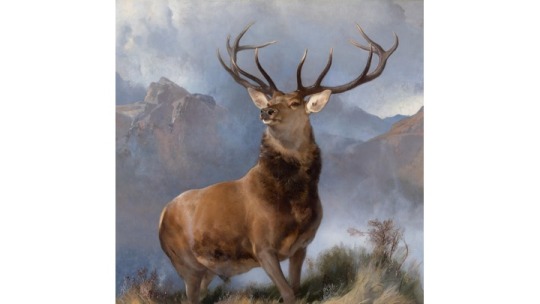
Deer stalking itself is steeped in myth and folklore. Geographer Hayden Lorimer writes: "The pursuit of deer, both as a pastime and as a livelihood, has a long history in the Scottish Highlands. Celebrations of these activities, preserved through several centuries in native Gaelic folklore, oral ballads and apocryphal yarns, were seized upon by the authors of stalking guidebooks, histories and personal reminiscences." Scottish 'deer' folklore was mined and appropriated by the cultural elite, giving deer stalking culture seeming authenticity.
The Highland Fling seems to be part of this process of appropriation. The story goes: Legend tells of a boy who encountered a stag; his father asked him to describe what he saw and, lacking adequate words, he danced the animal instead, his movements imitating capering, his hands held aloft for antlers. Becoming popular as an authentic dance of the highlands, it seems that deer mimesis gave the Fling credibility, but after some digging, I discovered that the story is more than likely a bit of 'fakelore' and probably invented by an eighteenth-century, Lowland dance teacher as a caricature of a 'wild' highland warrior who imitates deer. I couldn't help but think that this 'fakelore' shares striking parallels with the romanticisation of deerstalking, itself a mimetic performance of hunting traditions, reinterpreted and distorted into a form of macho display by landowning classes.

In Spring 2018, I began my studies in Highland Fling, taking lessons with dancer and teacher Sandra Robertson in Kinguisse. Sandra gave me a pair of leather ghillies – soft shoes traditionally worn in Highland Dance. Strangely, the word 'gillie' also means 'hunting guide' or 'male servant to a Highland chieftain'. The shoe's name is thought to be a type originally worn by Scottish hunting guides, who were servants to the lairds – there it was again: the working-class highlander at service to the landowning class and to the elite hunting economy.
I put the shoes on over my thick red socks and Sandra showed me some basic steps. Having done ballet up until the age of 19, I was accustomed to jumping, but the first thing to get used to was landing on the balls of my feet. This took some practice and on the evening after my first session, my shins were agony. Slowly, with time, I got used to it, and before long, I had learned six steps: shedding, rocking, toe and heel, backstep, crossoverand last shedding. It took me months of practice to get through the whole dance without stopping – it was exhausting! Anyone doing this dance regularly, had to be extremely fit.
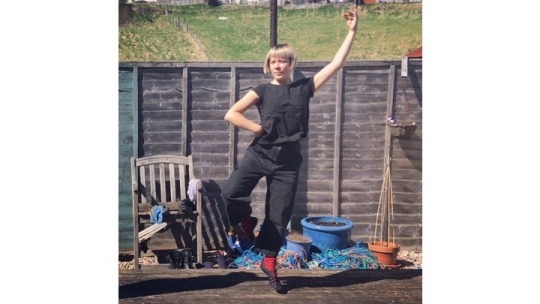
To help with my learning, I made visual scores of the dance, replacing arm positions with red deer antlers, and human foot fall with red deer tracks in a notation of the steps. I also began to experiment with blind debossing, inspired by seeing the tracks in the snow.

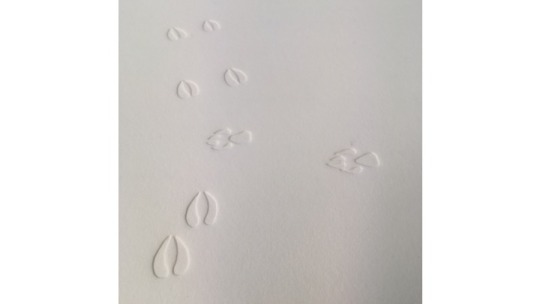
Romanticisation aside, learning the Highland Fling, I could understand why the story of deer imitation stuck. While dancing with deer in mind, the arms, when held high, felt like antlers. The steps, such as toe and heel, backstep and rocking were delicate and deer like, yet powerful and athletic. Two of the steps sheddingand last shedding seemed even to reference the stag's antler shedding, which happens once a year. I could imagine that if a dancer of the Fling performed well, it might make them feel powerful and elegant. I wondered how it might feel to perform this dance if I were a man?
Sonora Desert, Arizona and Mexico...
The indigenous Yaqui, or Yoeme tribe are originally from Sonora in northern Mexico. Seeking refuge from persecution by the Mexican Government in the 19th and early 20th centuries, some of this community were forced north of the border. Their descendants in the USA call themselves the Pascua Yaqui, and in 1978 they were finally recognised as an official tribe. Today, the Pascua Yaqui have eight communities in Southern Arizona.
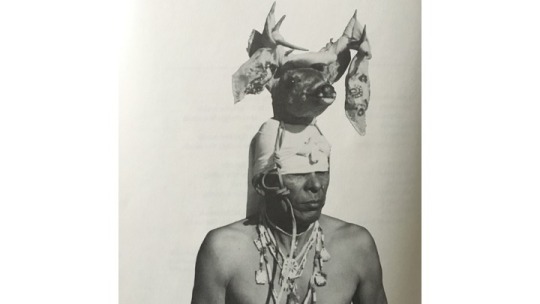
The Yaqui Deer Dance is a small but important element in the modern Yaqui ceremonial cycle, a ritual involving dance, music, pantomime, and poetry, in a complex blend of catholic and indigenous beliefs. Yaqui traditions speak of the Deer Danceonce being part of a rite performed before the hunting of the deer, but today that connection is only a memory.
Supported in part by the University of Arizona Poetry Centre, in March 2018, I went back to Arizona to begin to make connections with the Pascua Yaqui community. I met with Larry Evers, who co-authored the book on Yaqui Deer Songs mentioned earlier. He was about to retire from his role as a professor between the English and American Indian Studies departments at the University in Tucson, and when I visited, he was clearing out his office. Generously, he gifted me a pile of books and papers on Yaqui culture, as well as a set of DVDs with hours of footage of a Deer Dance ritual performed in Mexico in 1976. Of particular relevance to my research was an old type-writer written thesis, in which the writer Susan Burton explores the relationship of the Yaqui Deer Dancesteps to the movements of real deer and, using the 1976 film footage, notates the dance's vocabulary with labanotation.

Larry was excited by my research, though warned me that I would have many boundaries to cross. Firstly, my gender – the Yaqui Deer Danceis strictly a male domain – and secondly, my ethnicity as a white European. As with many First Nations people, the Yaqui tribe have been consistently ill-treated by various outsiders throughout history, from the invasion of the Spanish Jesuit missionaries and the Mexican Government's persecution of indigenous tribes, to the early American anthropologists misquoting traditions, and the US authorities' mistreatment of anyone who is not white. Understandably, the Deer Dance, and Yaqui culture more broadly, is rarely discussed outside the community.
I was readying Donna Haraway's book 'Staying with the Trouble' and the following passage resonated:
"Indigenous peoples around the earth have a particular angle on the discourses of coming extinctions and exterminations of the Anthropocene and Capitalocene. The idea that disaster will come is not new; disaster, indeed genocide and devastated home places, has already come, decades and centuries ago, and it has not stopped. The resurgence of peoples and of places is nurtured with ragged vitality in the teeth of such loss, mourning, memory, resilience, reinvention of what it means to be native, refusal to deny irreversible destruction, and refusal to disengage from living and dying well in presents and futures."
I wondered if it was possible to foster a meaningful dialogue and cultural exchange? To open up possibilities, Larry put me in touch with his long-term collaborator Felipe Molina, a Yaqui tradition bearer, teacher and translator, from Marana, Arizona. We exchanged emails and, though Felipe was interested in my research, he was too busy with his Easter commitments as a Deer Singer. We agreed to be in touch again later in the year.
During the Easter ceremonies, the Yaqui Deer Danceis held on two occasions, at the Pahko– an all-night Fiesta – and then again on Easter Saturday. Seeking permission to attend these, I contacted Daniel Vega from the Language and Culture Departmentof the Tribal Council at the Pascua Yaqui Reservation. At our meeting, I explained how I was exploring the imitation of deer across cultures in order to better understand their relationship to ecology and, sharing a little about my research so far, I was delighted when he showed a particular interest in hearing about the Abbots Bromley Horn Dance. He explained that the Yaqui tribe perform their various ceremonies as healing rituals, not just for the Yaqui, but for everyone around the world, so, if I went with respect, I was welcome to attend the Easter ceremonies at Old Pascua– the old village in South Tucson. He warned me not to take photos, make sketches or any recordings – this was strictly forbidden – and that I had to keep my cell phone out of sight.
Not quite knowing what to expect, on Friday evenings I began to attend the Lenten ceremonies, participating in the processions of the fourteen Stations of the Cross, following the various church groups who sang and prayed at each of the crosses positioned around the Old Pascua village. Also partaking in the processions was a ceremonial group called the Fariseos, who are said to represent those who persecuted Jesus. Within this group were the Chapayekas– masked figures who symbolise evil. One of the Chapayekas'ritual functions is to deride the procession and distract the church groups by silently mocking them, beating time with swords and daggers, and shaking the deer hoof rattles around their waists and moth cocoon rattles on their ankles. My initial reaction was to laugh at their pantomime-esque performance, but as the sun went down and the procession continued in darkness, they really felt quite sinister. I soon discovered that it is taboo to stare too closely at a Chapayeka.
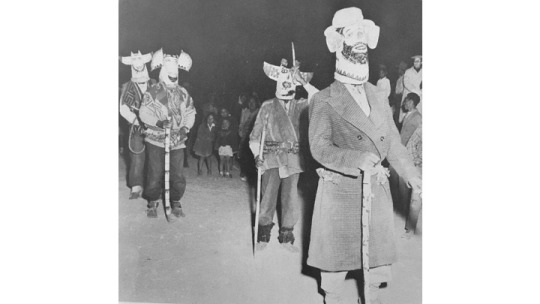
On Palm Saturday, I attended the Yaqui Pahko. Though I'd read so much about it, nothing could quite prepare me for the experience of this multifaceted, powerful night-time ritual. Approximately two hundred performer-participants, divided into about twelve groups, each with a distinct role and music, carried out ritual processes and costumed dances representing the various overlapping forces of good and evil. There was only one Deer Dancer though; at the Ramada, a structure symbolising Huya Ania (the wilderness world), the Maaso(the deer dancer) emerged as a timid fawn and, dancing alongside the Pahkola(a group of clown-like animal-esque figures), he slowly grew into a virile adult male through the night, before predicting his own death and concluding his dance as an animal spirit.

During a break in the ceremonies, I chatted with someone I'd met in the 'audience' who made a striking observation about how the Maasoalways has his torso tilted forwards, like the enigmatic Palaeolithic ‘sorcerer’ cave painting of the Trois-Frères caves in Southwestern France. I hadn’t made the connection before, though I had stuck an image of the ‘sorcerer’ in my sketchbook. The visual similarity is uncanny – was this how humans become-with-deer?
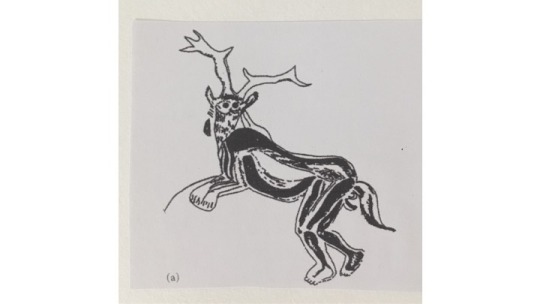
A similar sequence of Deer Dances took place on Easter Saturday, another complex, multi-layered ceremony, where, in a battle against evil, the powers of the more-than-human world were harnessed. Dancing Matachiniswore flower streamers in their hats, processing Angels waved branch-switches in the air, trickster Pahkolas wore animalesque masks, and, the Maaso (Deer Dancer), in his final dance, charged at the Fariseos, threatening with his antlers. Finally, when evil was defeated, the Fariseoswere ritually ‘killed’ by 'flowers', symbolised by paper confettithrown at them, and a straw ‘Judas’ was burned in a fire, along with all the Chapayekamasks and swords. Bells rang out from the church and celebratory music was played. With so much colour and joy, I felt like I never wanted to brush the confetti out of my hair!
In a closer examination of the Deer Dance itself, the combination of the dancer's movements and costume seems to span a spectrum of mimesis, from iconic deer imitation to something more stylised. The deer's headdress enhanced the sudden sharp-to-still deer-like movements of the head; soon enough, I found myself watching not the dancer's eyes, but the deer's eyes, partially hidden beneath the cloth. The long line and tension of the tilted torso suggested a deer's back, and the white cloth joining the dancer's head and deer head gave the impression of a deer's neck and shoulders. The flexed feet were reminiscent of the animal's hind legs, while the gourd rattles suggested the front legs, the movements of which gave the impression of a deer's speed and agility. The footwork itself – the choreographed steps – seemed less iconic and more stylized. I wondered if I would be able to meet and learn from a dancer some time...
The dance is traditionally accompanied by three musicians who sing and play instruments: the hirukiam,notched rasping sticks resting on half-gourd resonators said to represent the deer’s breath or the scraping of the antlers against the brush, and the ba’ abweha’i, a water drum made from a half gourd floating in a bowl of water, representing the heart-beat of the deer. Sitting on the floor during the dance,I could feel the vibrations of the water drum in my chest, and I imagined that the dancer might be tuning his heart into a deer's heart beating.
The songs accompanying the dance, are sung in Yoem noki(the Yaqui language) and describe the Maaso(the deer) and his encounters with other animals, birds, insects and plants, especially flowers, which hold a spiritual significance. The Yaqui believe that there is a close communication between all the inhabitants of the Sonoran Desert, which they call Huya Ania. This could be translated as 'wilderness world', but it is worth pointing out that the word 'wilderness' here, does not mean a "neglected, uninhabited, or inhospitable region" like it does in the Oxford Dictionary, but a living, connected community. This ecology of the Sonoran Desert appears in the traditional songs, which become like scores, or a script to the dancer who, as the deer, also becomes, for a moment, the badger that is being described, or the hummingbird, or the mountain lion.
Later that Summer, I returned to meet with Felipe and, over a number of meetings, learned more about the dance. We shared our perspectives and he generously answered my sprawling questions, teaching me about aspects of Yaqui culture, including some Yoem nokiwords. Felipe explained how the Deer Dance was a way for people living in the city to connect with Huya Ania (the wilderness world) and Sea Ania (the flower world), and as he described how the songs are lessons for listeners to learn about ecology and Yoeme ancestors, I began to think of the Yaqui Deer Dance as a form of activism.
I was honoured when Felipe invited me to give a talk to his students, a class of young Yoeme adults, who were learning about their culture at the Yaqui tribal chambers on the reservation. I shared a little about my work with vernacular traditions, specifically Scottish Highland culture and language, and about the history of the repression of Scottish Gaelic and the current resurgence of the language. It was good to hear Yoeme perspectives. Though the Yoem Noki language is under threat of dying out, people like Felipe are out there doing the work of preserving and passing on knowledge.
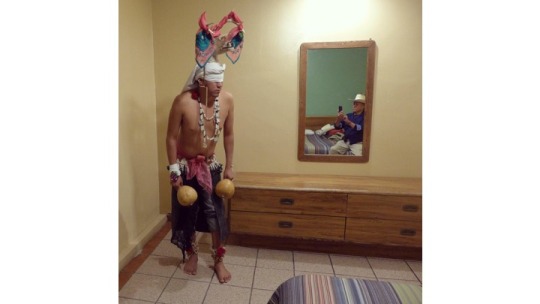
Felipe and I began to make plans to visit a Deer Dancer in Mexico later in the year and, in November, over a number of days, we went back and forth by foot across the Mexico-USA border, to work with Indalecio ‘Carlos’ Moreno Matuz, a young Yaqui Deer Dancerfrom Vicam, Sonora, in the Yoeme homeland. We worked in Carlos’ hotel room, where I interviewed him and learned about the physical and symbolic aspects of the dance through demonstrations and diagrammatic drawings, while Felipe translated from English to Yoem Noki and back again.

Felipe and Carlos explained that the dance had only ever been performed by men because they were the ones who traditionally went hunting. Interestingly,the deer behaviours imitated were less about the bravado and display associated with the rut, and more about alertness and agility as a form of defence. This corresponds with the fact that in Yoem Noki, there is no word for 'buck' or 'stag'; Maasosimply means 'adult male deer', though his other song names are displayed here. The only time the Maasodisplays aggressive behaviours, such as charging or threatening with lowered antlers, is when he is being attacked or provoked by other figures in the ceremonies.
The white-tailed deer – and coues-white-tailed deer – live in areas of the Sonoran Desert – a land that rambles over 320,000 km, across two countries. It is home to about 130 species of mammals, more than 500 kinds of birds, 20 amphibians, 100 or so reptiles, 30 native freshwater fish. There are perhaps as many as 2500 native species of plants and 4000 in total. It is also home to at least 17 Indigenous cultures as well as many others who have adopted it.
The tribal lands of the Yaqui have been irreversibly damaged, initially due to the European invasion and colonisation, and latterly by the rapid growth of capitalism and climate change degrading the ecology. Along the Yaqui River in Mexico, eight tribal villages have no water due to drought and the actions of agricultural corporations and, every year, people battle with wild fires caused by rising heat levels and invasive grasses spread by cattle. Although the culture of the Yaqui Deer Danceis being preserved, the ecology of the wilderness world is seriously under threat.
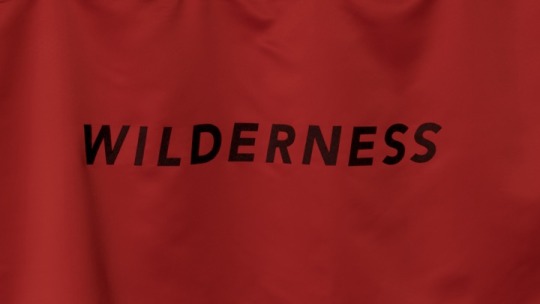
Wild-deer-ness
Throughout the process of exploring these dances, I considered how a body of work might emerge from my research. By conjuring the antlered male deer, the dances evoke images of wild nature, but I realised there is a disconnect between what is encoded in their movements and the reality of local ecology. I was also acutely aware of the striking relationship between our cultural perceptions of 'wilderness' and ideas of 'masculinity'.
How could I honour these folk traditions and histories, yet simultaneously critique and de-stabilise constructed problematic narratives? How could I address contemporary intersections of ecology, gender and class? How could I touch on the complex relationship between indigenous cultural knowledge and the appropriation of vernacular culture? What did I want to explore and communicate?
I spent time writing, thinking, dreaming and in my note books began to distil my research into words:
From Palaeolithic cave paintings, to Landseer’s Monarch of the Glen, throughout time, artists have made representations of deer. Whether as staples to hunter-gatherers, icons of power and empire, or the focus of sport, deer have long been central to human cultures.
In popular imagination, deer remain etched into people’s consciousness as emblems of the 'wild' – the word wildernessitself, derives from the Old English wilde, wild, and doer, deer – and our relationship to the idea of wild-deer-nesshas shaped the landscape. Transported across continents, some species, such as fallow and sika deer, transformed ecologies with the establishment of royal deer forests and parks – hunting grounds belonging to the Crown. Other species, such as the reindeer of the arctic tundra and white-tailed deerof the Sonora desert, face threats of habitat loss caused by climate breakdown. In Scotland, the overpopulation of red deer due to human made environmental change impacted greatly on the degradation of Caledonian pinewood ecology.
And so, it follows, although they are perceived as powerful, deer also embody vulnerability. Constantly alert to the threat of a hunter or predator – or the ‘ghost’ of an extinct predator – they inhabit vulnerable places. It could be said that deer do not live in wilderness, but in ghosts of places that no longer exist.
Across timescales and cultures, our relationship with deer as a totemic and ideologically powerfulanimal has contributed to a construction of wilderness as an imaginary landscape, setting 'nature' apart from 'culture'. Is it possible to shift our relationship to the world and renegotiate these dichotomies?
The dancers at Star Carr, the Abbots Bromley Horn Dance, the Yaqui Deer Dance and the Highland Fling are separated by geography and time, yet there is a commonality in these seemingly disparate cultures, which find echoes throughout history, fromthe ritualised carrying of stag heads condemned by medieval European church leaders, and Herne the Hunter, the antlered ghost of a royal gamekeeper in English folklore, to the Tibetan stag-headed Chamdance and Shishi-Odorideer dance of Northeast Japan.
Evolving over generations, each dance is mimetic in some way, with movements that imitate male deer behaviour and gesture, from the frolicking of the fawn and the alertness of the adult male, to the bravado, display and aggression of the rutting stag.Costumes also play a significant role, and often, but not always, feature elements of attire made from animal parts. Another common feature is that they are (or were) traditionally performed by men and, with their displays of muscular strength and athletic endurance, they are all thought to have their origins in (or associations with) hunting ritual practices.
As traces of hunting rites, how are these dances to be understood within a contemporarycontext?
How does the mimesis of male deer behaviours inform a 'performance' of masculinity by male dancers? What are the implications of these gendered performances in society today?
Returningto the animal tracks that obsessed me, back in the studio, I finished scoring the three deer dances I had studied, tracking the steps of the dancers, replacing human foot-prints with deer hoof-prints: red deer for the Highland Fling steps, white-tailed deer for the Yaqui Deer Dance steps, and reindeer for the Abbots Bromley Horn Dance steps. Working with Edinburgh Printmakers, I developed these into a series of blind debossed prints.
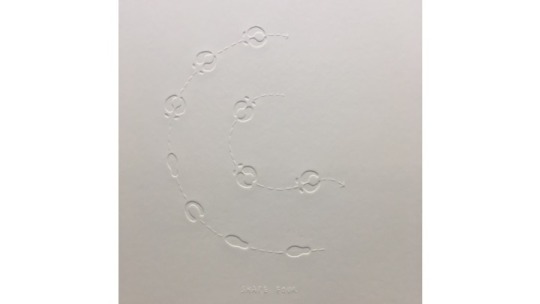
Becoming-with-deer
Considering different approaches to choreograph from the scores, I decided to draw upon the most mimetic aspects of what I had learnt and adopt fragments of steps to make something entirely new. But who would perform this? Drawing on multiple layers of my research, I began to conceive of a series of characters, each one a constructed assemblage of aspects drawn from a male-deer/male-human spectrum, playfully dissolving human:animal binaries. Making sketches of these figures, I gave each of them names borrowed from archetypal male characters found within traditional theatre, as well as deer and deer stalking terminology: monarch, warrior, young buck, fool and old sage.
To get to know them with my body, I decided to attempt to become each deer-man myself. By queering these figures, I hoped to challenge our constructed ideals of masculinity and question the mythologies that give authenticity to gendered behaviour. Having experienced some of the more negative and toxic behaviours of the heroic-hetero-male in my day to day life – let's call this thecrisis of masculinity– I also wondered if, by becoming these characters, I could release myself from their impact on me as a queer woman, and simultaneously bring to the foreground the impact of these behaviours – the crisis of ecology– on vulnerable and damaged habitats.
My plan became to create a moving image and sound work, performing each character in a choreography-to-camera. I began to collaborate with two performance artists: Peter McMaster and Will Dickie, who both practice at the intersection of live art and dance, and whose past work had, in various ways, explored tropes of masculinity, ritual and ecology. Peter collaborated with me on the film's dramturgy and Will became the movement director, helping to devise the choreography. Together, we discovered and developed the characters.
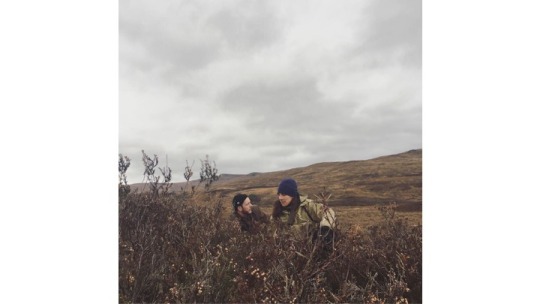
To begin our process, in October 2018, we spent a few days at Trees for Life, workshopping ideas and watching deer. We also went out deer stalking with Allan. This time I was very sensitive to his movements, almost reading him as a dancer, and was struck by the ways in whichhe took on qualities of the animal of the hunt, harnessing deer-perspective.Like the deer, he was quick to register distant movements and sounds and, on getting close to the animal, to remain hidden, he tilted his torso with bended knees, a pose strikingly similar to the Yaqui Deer Dancer's basic posture and cave painting of Trois-Frères.Will made an interesting observation about how the deer stalk appeared to be carried out in clearly defined ritualised stages. Beginning casually, walking upright and chatting, we slowly grew tighter as a pack, becoming quieter and more focused, tuning in to our surroundings and, as we drew near to the deer, we got close to the ground, not moving or making a sound, our bellies up against the heather. Before taking a shot, Allan spoke about a moment of stillness – a stillness of breath and of thought.
In a similar way, each dance that I had been studying, sat at a different stage in the ritualised drama of the hunt: the Yaqui Deer Dancetraditionally took place before hunting, allowing the hunter to access the perspective of the deer; the Highland Flingwas a dance of triumph, a dance to feel powerful and in control; and the Abbots Bromley Horn Dancewas a celebration after the hunt, to give thanks. With gestures that ranged from iconic imitation to stylized metaphor, these rituals of the hunt were clearly mimetic of the rituals of the deer rut. But how could the dramaturgy of my film address what felt urgent to me: the interconnections between the crisis of masculinity and the crisis of ecology? We slowly began to realise that if Deer Dancer was to function as a ritual space, perhaps the characters would have to stalk each other to the death...

Early the following year, Will, Pete and I worked together to discover the five characters from the inside, developing their movement vocabulary and training exercises and, as we explored the relationship between them, a story emerged. I began to conceive of a two-channel film and sound work that would play with, and attempt to destabilise narratives found both the within anthropology documentary and wildlife/nature documentary. To prepare for the filming process, I created a story board for the two screens, and composed and recorded a multi-layered vocal composition to perform to.
Utilised technology to 'extend my body' and expand my vocal range into 'male' and 'stag' pitches, I worked with my voice to imitate drum sounds. Recalling my experience of the Yaqui water drum, and the Abbots Bromley Horn Dancetriangle, my intention for the sound was to affect the viewer-listener on a body level, sometimes in a way that is unsettling, at other times like a heart-beat of low vibrations in the chest or belly. Alongside the process of developing the characters physicality, and the vocal score, I began to design and make the costumes and props, with invaluable assistance from my partner Lydia Honeybone, using an assemblage of materials, from ribbons and sequins, to bullets and hunting horn. I also worked with naturally cured deer hide, hooves, antler and skull, specifically for the cod pieces, and the weapons, hinting at the relationship between the posturing of male sexual bravado and violence.
We filmed over three days in Glasgow University's theatre against a black curtain. My director of photography Andrew Begg lit the space, and followed the story board shot by shot, filming each character one by one, then, in post-production, with editor Laura Carreira, I then pieced together the jigsaw puzzle.

Introducing the characters...
The Monarch is a mature, dominant male, who holds his head high, displaying his sixteen-tine crown and enlarged neck. Over his hide, he wears gold. His stance is wide and a bulbous codpiece with tassels enhances his majesty. Belling loudly, he asserts his authority, warning off rivals to his harem of hinds. But he's growing old and his limbs are becoming stiff. Soon he'll be past his prime.

The Warrior is highly alert, his senses tuned into his surroundings. He tracks and hunts, defending himself on attack with antlered spears that extend from his shoulders. He's in his physical prime; his chest is hard and strong and over his tartan loins, he wears a sporran and bullet belt. When he hears his rival, he sounds his horn, displaying his power.
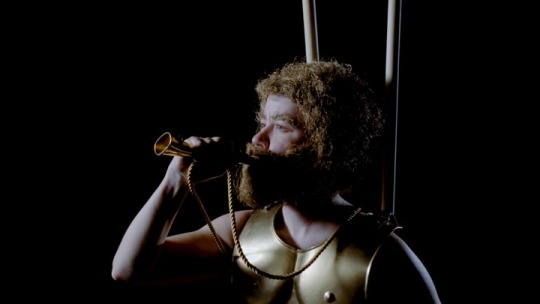
Though the Young Buck has reached sexual maturity, he's still a spiker, yet to win his own harem. But he's looking. Dressed in tweed trews and protruding codpiece, he taps the ground, addressing potential rivals. He is lustful, cocksure and trigger-happy, challenging anyone in his close proximity. Breathing heavily, he's on the hunt for a hind, on the hunt for a fight.

The Fool, small in stature, avoids the dominant males as they proclaim their authority during the rut, bawling and displaying his white behind in fear. Wearing ribbons, bells and a modest codpiece, he carries a broom with antlers, a hobby stag that appears to push and pull him into combat. Haunted by ghosts, this skittish staggard is bewildered by his own inner conflict.
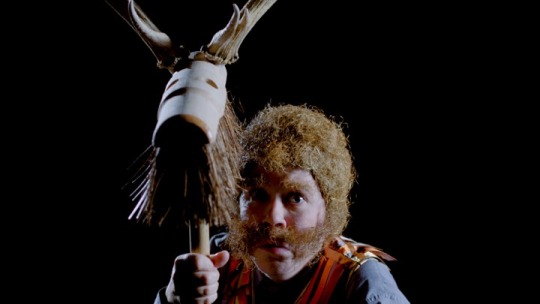
The Old Sage is a spirit of the wild hart and ghost of a man. Haunting the wilderness with skull and ragged horns, he relives his life tending the land with hooves and hands. He also relives his death. Only perceived by a few, he sees all.
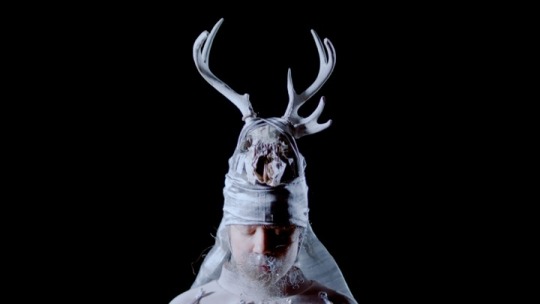
Deer Dancer
In the resulting work, the costumes, movements and music work together to tell a story, with the visual scores acting as hidden keys to the work. In the 'pop up theatre space' of the gallery, we meet the five characters in an imaginary wilderness world. This wilderness world is not rooted in a particular ecology, but is place-less, black and empty, allowing the viewer-listener to construct and project their own wilderness into the space.
A dynamic emerges between these deer men, and slowly they begin to stalk one another.Then, in a face-off, they lock eyes, take a bow and the deer dancecommences. With movements that signify both the deer rut and a pre-hunt ritual, the characters face one another, performing their ritual dance, with fragments of steps from the three dances. In the visual scores, these steps are delinieated in gold foil on the debossed tracks – interestingly, the word 'foil' also means 'animal track'.

Then, coming to a stop, one by one, the deer-men draw their weapons, and we see each one lying in their death pose, with blood flowing from their body, signified by slow moving red ribbons. As bodies disappear (or decompose), the costumes remain as relics of culture to be performed again. Bit by bit, they too disappear, until then reappear on my body, piece by piece, reconstructing each character in a queer assemblage. And then it begins again...
Stuck in a perpetual loop of learned behaviour and appropriation, these stag-men are ultimately condemned to self-destruct. Humankind has left a footprint so deep that we are only now beginning to grasp the immensity of the calamity. In a small way, I've come to think of Deer Dancer as a contemporary life-crisis ritual for a damaged planet. But when the balance has been set right in ritual, the question becomes how do we really address the damage?
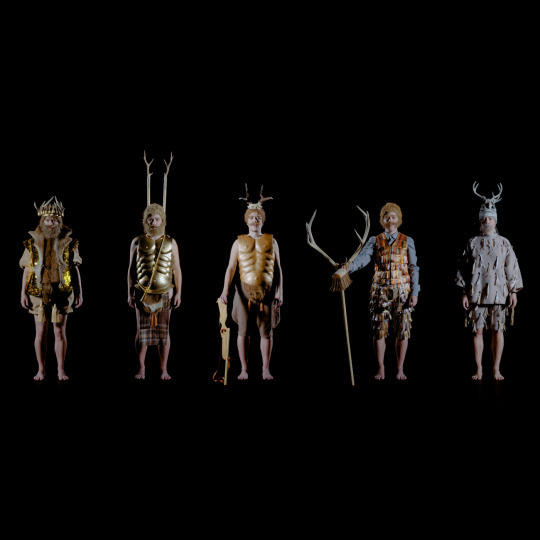
This text was originally written and presented as a talk at Edinburgh Printmakers in September 2019, to accompany Tuulikki’s Deer Dancer exhibition.
Deer Dancer credits: Performed & directed by Hanna Tuulikki; Character development and choreography by Will Dickie, Peter McMaster and Hanna Tuulikki; Dramaturgy by Peter McMaster; Movement direction by Will Dickie; Sound composed and recorded by Hanna Tuulikki; Sound mixed with Pete Smith; Director of photography by Andrew Begg; Edited by Laura Carreira; Costume fabrication assistance and wardrobe management by Lydia Honeybone; Production management by Amy Porteous; Costumes and print works by Hanna Tuulikki
Developed through conversations and interviews with tradition bearers and academics, Felipe Molina (Yaqui tradition bearer/ translator), Larry Evers (American Indian Studies, The University of Arizona), Jack Brown (Abbots Bromley Horn Dance tradition bearer/ historian), Doug and Joyce Gilbert (Trees for Life); by observing a number of dances and participating in rituals, including the Yaqui Deer Dance (Pascua Yaqui Easter ceremonies, Old Pascua, Tucson, Arizona, March 2018), Abbots Bromley Horn Dance (Abbots Bromley, September 2017/2018); and direct learning with Sandra Robertson (Highland Fling), Indalecio 'Carlos' Moreno Matuz (Yaqui Deer Dance), Gary Faulkenberry (animal tracking, March, July 2018), Allan Common (deer stalking at Trees for Life, Dundreggan, autumn 2017/2018).
Commissioned by Edinburgh Printmakers, funded by Creative Scotland. Research and development supported by Magnetic North's Artist Attachment, funded by Jerwood Foundation and Creative Scotland. Additional support from Hope Scott Trust, The Work Room, University of Arizona Poetry Center, Trees for Life, University of Glasgow, Glasgow School of Art, and CCA: Centre for Contemporary Arts, Glasgow.
16 notes
·
View notes
Text
THE BEST TRAVEL SHOWS ON NETFLIX – TRAVELUR
Let’s be honest, it’s not always possible for a person to travel and spend so much money. Corporate jobs, the time factor, money – all these tend to come in one’s way of exploring the world. But that shouldn’t deter you from your passion for travel. Whether you’re looking for exotic food destinations, or need help in deciding another vacation destination, this list of travel shows and documentaries on Netflix will help you do just that!
Here is a list of 8 travel shows on Netflix that you must watch if you are a travel enthusiast and wish to inspire adventure. Am sure, most of these travel shows will have you booking a flight even before the series is over.
1. DEPARTURE:
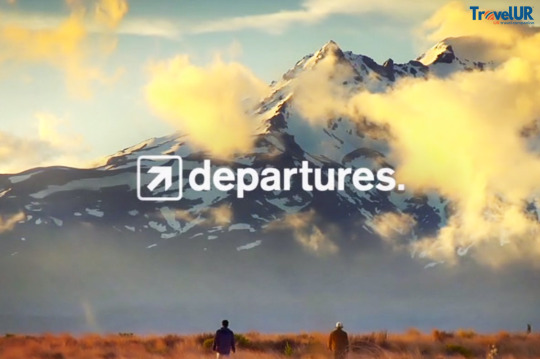
Departures are about two friends, Scott and Justin as they head for a year of around the world travel along with their camera. They cover several countries like India, Cambodia, Indonesia, and Cuba, etc. giving insights about each country, the beautiful views, and the exotic food as they travel. This is one of the best travel shows on Netflix. This show about their adventures and misadventures is so relatable that you’ll see some of yourself and your travels in them, for sure!
2. TALES BY LIGHT:

Tales by Light isn’t any regular travel show but a show where the main focus is the photographer i.e. the person behind the camera, the challenges they face, the stories they tell, etc. In this two-season long series, the photographers happen to be some of the best in the world who globe trot to simply find the best shot. The creators have tried to cover every corner of the world in these two seasons full of breathtaking episodes and crazy escapades. Just so inspiring!
3. SOMEBODY FEED PHIL:

Somebody Feed Phil has been created by Phil Rosenthal, creator of the successful sitcom “Everybody Loves Raymond”. In this show, Rosenthal travels around the world while eating that country’s traditional food and meeting new people. It’s hilarious to watch an American who is so clueless when it comes to foreign dishes. This series is no doubt as much about Rosenthal’s travel journey as much as it is about a great meal with new friends!
4. PLANET EARTH:

Touching almost every geographical corner the world has to offer, this series is a treat to the eyes. BBC spent years filming the wild world which paid off by finally becoming the most influenced documentary on food and travel filmmaking. This series is for all the travel buffs out there who wish to take a look beyond human culture.
5. THE WORLD’S MOST EXTRAORDINARY HOMES:

The World’s Most Extraordinary Homes is a British documentary miniseries wherein the hosts – award-winning architect Piers Taylor and Actress/property enthusiast Caroline Quentin travel the world to take you inside the architectural marvels and unconventional homes of people. Whether built into the side of the cliff, on top of a mountain, nestled in a forest or hidden under the earth, they shall explore a range of incredibly designed houses, stay overnight, eat meals and spend time in the homes. According to the audience, this show is super addictive. Well, it’s time to watch it, isn’t it?
6. CANON WITHOUT BORDERS:

Conan Without Borders is a late-night talk show where the host – Conan O’Brien hits the roads and travels to various parts of the world where he meets different people, enjoys the food and culture and infuses all of this with his trademark humor. He has a knack of getting people to open up, lighten their moods with his humor and thereafter delve into serious topics like a war or any humanitarian crisis.
7. DARK TOURIST:
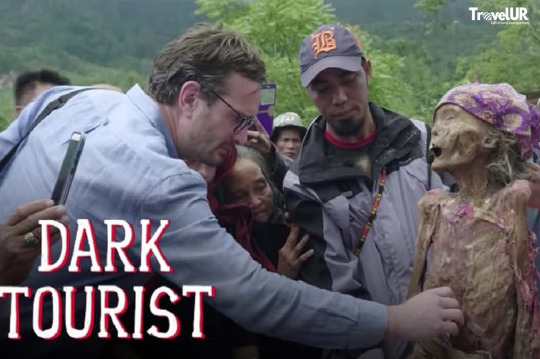
Dark Tourist isn’t any ordinary travel show – but an extremely interesting and bizarre show that revolves around “Dark Tourism” ie experiencing haunted houses, war zones, radioactive towns, disaster-stricken areas, etc. This travel show covers places one wouldn’t have even heard of in countries like Japan, USA, Kazakhstan, etc. This show not only helps to know more about these peculiar places around the globe but also helps increase your knowledge about the world.
8. JACK WHITEHALL: TRAVELS WITH MY FATHER:

Jack Whitehall, a British comedian decides to take a sabbatical and explore different countries around the globe. It’s a super fun show where he even takes his father along – someone who is not so fond of traveling to new countries. This show is a perfect blend of comedy and travel as they explore countries like Vietnam, Phuket, Hanoi, etc.
2 notes
·
View notes
Text
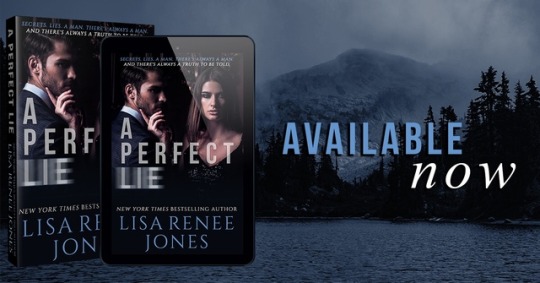
Title: A Perfect Lie
Author: Lisa Renee Jones
Release Date: May 14, 2019

ABOUT A PERFECT LIE
Secrets. Lies. A man. There's always a man. And there's always a truth to be told.
I'm Hailey Anne Monroe. I’m twenty-eight years old. An artist, who found her muse on the canvas because I wasn’t allowed to have friends or even keep a journal. And yes, if you haven’t guessed by now, I’m that Hailey Anne Monroe, daughter to Thomas Frank Monroe, the man who was a half-percentage point from becoming President of the United States. If you were able to ask him, he’d probably tell you that I was the half point. But you can’t ask him, and he can’t tell you. He’s dead. They’re all dead and now I can speak.
BUY A PERFECT LIE
Amazon US → https://amzn.to/2PUIGLj
Amazon UK → https://amzn.to/2PUBNtq
Amazon CA → https://amzn.to/2PRbsMI
Audible → https://adbl.co/2TJMTb1
iBooks → https://apple.co/2p09PB4
Nook → http://bit.ly/2MrIqB5
Kobo → http://bit.ly/2NCgK18
EXCERPT
“Can I join you?” he asks, motioning to the table.
There’s interest in his eyes, the kind a man has for a woman, but who knows, maybe it’s real or maybe it’s not real. Maybe he knows who I am and sees a path to power and fame. The way Tobey wanted me for money and power, right up until the moment I’d called his number aka his agenda; thus, he has not called me since I left. Maybe Harvard will lie even better than Tobey did. Maybe Harvard will at least kiss better than he did, and the lies would taste like temptation rather than convenience. At least then, if I’m used, I’ll enjoy being used.
Whatever the case, it’s clear I might actually be angry with Tobey and that aside, the interest that Harvard has shown in me, must be controlled before my Denver sanctuary is destroyed. “You can join me,” I say, “but only because I’m trying to save the rest of the place from the attorney in the house.”
I am pleased when Harvard laughs, where Tobey would have scowled, proving that Harvard has a sense of humor, which is rare for those in my life. I’ve barely completed this thought when he moves forward and claims the seat next to me, not across from me, settling his briefcase on that chair instead. In the process, his leg brushes my leg and for the briefest of moments, I’m transported back to the place that I’m now trying to forget: to Austin, to Drew’s leg next to mine, his wink, and I do now what I did then. I jerk back. If Harvard notices he doesn’t react. “Since we haven’t been formally introduced,” he says, resting his naked hands on the table. “I’m Logan. Logan Casey.”
“Logan Casey,” I repeat trying to ground myself in the present, at least for now, but some part of me is still swimming in that memory, which naturally has me wondering if this man is a shark in the water around me. “Two first names,” I add. “Sounds like your parents fought over who got to pick your first name. Did they draw straws for which choice became your middle name?”
“You’re actually right on target,” he says, laughing again, and it’s a nice, masculine laugh, and oddly this thought feels familiar while Logan does not. “No one has ever guessed that,” he adds. “My mother won the name war. The women always win. Speaking of names. Do you have one?”
“Hailey Anne Pitt,” I say, “and in my house, my father won the name war.” Because in my father’s world, I add silently, the women don’t win the wars. At least, not that he knows, not in an obvious way. I’ve learned this well.
“Well then, Hailey Anne Pitt,” he says, “what’s a Stanford girl like you, doing in a place like this? You’re a long way from school.”
I’m smacked in the face with a lesson I’ve long ago learned and forgotten with this man; strangers do not always remain strangers and all offhanded remarks can come back to haunt you. “That was a joke,” I say, shutting the door connected to my real life, and a path that leads to my father. “I hate attorneys, remember?”
He narrows his eyes on me, and for no reason other than instinct, I believe he’s looking for a lie that he won’t find. I’m simply too well-taught from birth, too skilled at being more than one person to allow such a detection. Well that, and the fact that I really do hate attorneys, which is why I’ll be a good one.
“That was a joke?” he confirms.
“Yes,” I say. “Are you amused?”
“Yes, actually. I am. What does a lawyer-hating smart ass like yourself do for a living?”
“When not busy taunting those who went to law school,” I say. “I’m an aspiring artist.” Both honest answers, if you put a “was” in front of the “aspiring artist” which I’d thought that I’d come to terms with, but the knot in my stomach says I have not.
Logan motions toward the art room. “Your career explains why you ended up here.”
“I guess it does,” I say, as this place serves me well to reconnecting to the Pitt part of my life, which is a place I really need to be right now, for all kinds of reasons.
“Are you good?” Logan asks, as if he’s read my mind.
My father’s words answer him in my head. Art is useless unless you’re famous, he used to say often, because of course, it was inconceivable that I might be good enough to be famous. “Art is like movies and food,” I say, shoving aside that bad memory. “Good is subjective.” I don’t give him time to reply. I ping the conversation back toward him. “What kind of law do you practice?”
“Corporate,” he says, and this time he pings back to me. “Do you live in the neighborhood?”
“Yes,” I say simply. “Do you?”
“I bought a building a few years ago where I live and work which means this is my home turf, and why I know you’re new here.”
“I am,” I say and since he’s clearly going to ask for details, I quickly preempt with an on-the-fly story. Actually, it’s the suggested story, Rudolf included in my file. “I came here for a job, and my new boss owns a house he’s rented to me for dirt cheap.”
“And what does an artist do but create art for a living?”
“I’m working for a private art acquisitions firm. I now hunt for treasures for a living.” This lie is actually my dream job that I’ve never been allowed to entertain.
The horror flick loving waitress delivers my coffee and brownie. “Thank you,” I say, because every politician’s daughter has manners beaten into her.
“No problem,” she says, “but if you come to your senses and want a better version of that coffee, just shout.” She eyes Logan. “I already know you want a crappy tasting coffee, on endless pour and a chocolate chip cookie. Coming right up.”
“Thanks, Megan,” he says, giving her a wink that I don’t classify as flirtatious, just friendly, and Megan is gone.
“Obviously you’re a regular,” I comment, “and they even like you.”
“And they like me,” he confirms, “despite knowing I’m an attorney.
“Because you’re good looking and use it to your advantage.”
He arches a brow. “You think I’m good looking, do you?”
“Oh, come on,” I say, crinkling my nose. “Everyone thinks you’re good looking. I’m simply stating a fact. We use what we have and those of us that are smart, know what we have.” I move on from what is really quite inconsequential. “Why work here, not at home, or in the office?”
“I find I get a lot of work done with a cookie, coffee, and no access to streaming television,” he explains.
No one in my D.C. crowd would make an admission of being human and distractible. Some people in my situation might take comfort in that fact, but I don’t. Logan’s an attorney, and my gut, which I’ll confirm with research, says he’s a powerful one, the kind that radiates toward my father. Maybe that’s a coincidence and maybe it’s not. Maybe he’s testing how well I execute my cover story. The possibilities are many. Though in all fairness to Logan, perhaps I’d lean toward his innocence, if not for the laundry list of recent events such as Tobey being gay and the FBI agent, who is likely working for my father, that I slept with to prove I was a) still desirable and b) not a killer.
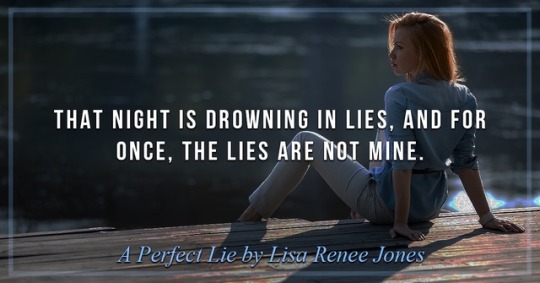
ABOUT LISA
New York Times and USA Today bestselling author Lisa Renee Jones is the author of the highly acclaimed INSIDE OUT series.
In addition to the success of Lisa's INSIDE OUT series, she has published many successful titles. The TALL, DARK AND DEADLY series and THE SECRET LIFE OF AMY BENSEN series, both spent several months on a combination of the New York Times and USA Today bestselling lists. Lisa is also the author of the bestselling WHITE LIES and LILAH LOVE series.
Prior to publishing Lisa owned multi-state staffing agency that was recognized many times by The Austin Business Journal and also praised by the Dallas Women's Magazine. In 1998 Lisa was listed as the #7 growing women owned business in Entrepreneur Magazine.
CONNECT WITH LISA
Newsletter ➜ http://lisareneejones.com/newsletter-sign-up/
Bookbub ➜ http://bookbub.com/authors/lisa-renee-jones
Amazon ➜ https://amzn.to/2MoWosB
Twitter ➜ https://twitter.com/LisaReneeJones
Instagram ➜ http://instagram.com/lisareneejones
Goodreads ➜ https://www.goodreads.com/LisaReneeJones
My Review!
5 ⭐️
Riveting!!!
Wow! This is a riveting, suspenseful, mystery that is about greed, destiny, betrayal, secrets, lies, power, money and ambition. It’s about what some powerful people may do to get ahead. But is also the story of a young woman Hailey Anne Monroe whose father has political aspirations to become the President. A father who appears to be disdainful of rules, of laws and of ethics. Raised from infancy to be the perfect daughter, Hailey tells us her story, as she searches for answers, and finds out what she is truly made of. Written in past and present tense it takes you on her journey of what she says is the truth. But is it? Or could it be the perfect lie?
This story took me on a wild ride, making me question every single character and situation the whole way through. There were little hints along the way that built this story, so many little things that started to tick off this list of what was real and who was behind all of this. I spent most of the chapters mentally keeping track of all the big and small clues. My mind constantly racing trying to figure out where this was all leading next. Because we have learned that in politics and life that lies can and are avoided by the many versions of the truth.
Lisa Renee Jones did a phenomenal job crafting this story, and I was held captive until the end. I loved its fast pace and unexpected turns. So clear your schedule. Bring a snack. This will keep you reading late into the night. I couldn’t put it down. I highly recommend this story.
I voluntarily read and reviewed an advanced reader copy of this book. All thoughts and opinions are my own.
2 notes
·
View notes
Text
This is one history lesson that you won’t fall asleep in!
Escape rooms are everywhere today – from physical locations around the world, to virtual games online, and in movies and TV shows. Amazingly, just a decade earlier, the vast majority of people around the world would not have heard of escape rooms. Have you ever wondered about the history of escape rooms? Which was the very first escape room in the world? When and where was India’s first escape room set up? How did online escape rooms become so popular? Questions like these, and more, are answered in this blog post. A brief history of escape rooms (as in 2022) Text-based escape games.
Interactive role-playing entertainment. Real Escape Game in Japan. Parapark in Hungary and HintHunt in the UK. Real Escape Game (San Francisco) and Puzzle Break in the USA. Clue Hunt in India. Online/virtual escape rooms take off during the 2020 COVID shutdown. What is an escape room? What are the features of an escape room? Yes, you have a very good idea of how an escape room works, and why they’re such an awesome thing to do with family and friends. However… There are other kinds of games, like mazes, haunted houses, scavenger hunts, ‘interactive entertainment’, which resemble the escape room experience. Here are the features what is escape room that make the escape room game completely unique… It takes place in one or two spaces; you don’t have to waste time walking from point to point. There’s a time limit, usually 60 minutes. It places the players in a dramatic storyline, like a haunted house. Players have to effect some kind of a ‘solution’ or a ‘resolution’, like finding out the reason behind the house being haunted (continuing the above example).
Players have to actively take part – finding clues, solving puzzles, and accomplishing tasks. The design of the puzzles and the tasks, combined with the time limit, makes it critical for players to communicate among themselves. They don’t require specialized knowledge or skills. They aren’t physically challenging or demanding. Now you know, for example, why the history of escape rooms doesn’t stretch back to ancient Greece, when the world’s first labyrinth (a very complex and large maze) is said to have been built. Precursors to escape rooms – live-action entertainment and ‘point and click’ video games The closest precursors to escape games as we know them would be a kind of click-and-point video games and various live-action, interactive entertainment forms that were born in the early 2000’s. Text escape games In 1988, software programmer John Wilson created a game called Behind Closed Doors. I’ll let you guess what the game was about. This was a text game, that is, it consisted entirely of text, instead of graphics.
Players would have to input text commands, such as run game (to start the game), open chest, get object, and so on to control the game… And the program would respond with output text, telling the players the result of their commands. As ancient as this sounds, you can guess this built interaction into the gameplay – that is, the player can interact with the game environment and decide how to proceed. Click-and-point ‘escape the room’ games During the 1990’s, several click-and-point escape the room type video games, like Planet Mephius Myst, and Crimson Room (the most successful game of this kind)… …were developed. These involved players trying to escape from a room or a location, using the pointer to find and uncover clues and perform actions. Apart from the obvious (visuals and graphics always score over text), this was a step up from the text escape game. It didn’t require the game to spell out the options available to the player in the form of output text. The player had to see and interact with the game environment and find out what options they had. In-person, live-action, interactive entertainment Live Action Role Playing entertainment were a crucial precursor to the modern escape room. During the early 2000’s, theater performers and game developers tried to innovate ways of scaling up their offerings, and turning the audience into active participants in the performance.
This resulted in the creation of in-person, live-action interactive entertainment. In-person – as they required participants to be present in person at the game site. Live-action – as they took place in real life, not on a computer screen or a gameboard. Interactive – as participants could actively engage with the proceedings, instead of passively following them. The best-known of these are: True Dungeon – inspired by Dungeons and Dragons, this pits players against a series of challenges, finding weapons, earning XP, and so on. First hosted in 2003. Sleep No More – a performance based on Shakespeare’s Macbeth. It allowed participants to move through the arena and interact with various characters and elements at their own pace. First performed in 2003. 5 Wits – a real-life adventure that includes a storyline, tasks and puzzles, but may not have a clear and satisfying endgame. Set up in 2004. While we’re getting closer and closer to the escape room, the gameplay clearly differs from the typical escape room scenario…as I’m sure you can see. The very first live escape room game – Real Escape Game The very first escape room in the world was Japan's Real Escape Game. The very first live escape room game in the world was Real Escape Game, set up in 2007 in Japan by an entrepreneur by the name of Takao Kato. He wanted to create a new form of entertainment, and got the inspiration for an escape room from a girl who was hooked on the online escape-the-room type games. Takao had created his new game as an event instead of the permanent escape rooms we have today. Even with minimal advertising, tickets got sold out quickly. The first one was in Kyoto, where a hundred and fifty people took part but only six managed to escape. Takao then set up a new and larger game…this time in Osaka. T
his too proved wildly popular. The sustained popularity of these temporary events persuaded Takao and other enthusiasts and entrepreneurs to design permanent location escape rooms… And it wasn’t long before escape rooms started opening up all over Japan, China and other Asian countries. Escape rooms take off in Europe – Parapark and HintHunt In 2010-2011, a Hungarian social worker by the name of Attila Gyurkovics got inspired by online find the object and escape the location type games. He wanted to create something similar in real life. And the first escape room in Europe – Parapark in Budapest, Hungary – was born. In 2012, Attila Nagy and Csaba Vinkler set up HintHunt, the UK’s very first escape room, in London. Escape rooms reach the United States – Real Escape Game in San Francisco Escape rooms first appeared in the USA in 2012. Remember Takao Kato from earlier? His friend Kazuya Iwata opened a Real Escape Game franchise in San Francisco in 2012. This was the first escape room in the United States. Next year (2013), Microsoft and EA alum Nate Martin set up Puzzle Break in Seattle – the first American escape room company. That same year (2013), India too got its very first escape room – Clue Hunt, in Bandra. And there’s been no looking back.
The 2020 pandemic and online escape rooms Like most physical businesses, the 2020 pandemic and shutdowns across the globe hit the industry hard. But rather than accept defeat, the industry innovated. Some got their game masters to strap on cameras to their heads, with the idea of offering a streamed adventure online. Others licensed virtual escape games, and offered those as an alternative to physical escape rooms. On the other hand, the people that were stuck at home really enjoyed the chance to have a thrilling experience with their loved ones online. And online escape rooms have become a part of the industry ever since – a wholesome complement to physical escape rooms. The escape room industry, post-2020 Despite challenges such as growing input costs, the brutal shutdown of 2020 and lingering after-effects of the COVID pandemic, The escape room industry has grown in strength across the globe. We’ve spawned legions of ordinary fans, movie franchises (Adam Robitel’s Escape Room), TV programs like Celebrity Escape Room, and on and on. We are an intrinsic part of modern entertainment culture. Searching for an escape room near you? Searching for escape rooms near you? Google ‘escape room near me’. Provided you don’t live in a completely offbeat location, you’re sure to get multiple search results. Go through the escape games they have, and book one that appeals to you! Oh, and if you liked this blog post, make sure to bookmark our blog as we’ll be publishing content on escape rooms, Hyderabad, and other cool topics regularly!
1 note
·
View note
Text
Behind The Album: A Moon Shaped Pool
Radiohead‘s ninth studio album was released in May 2016 through XL Recordings. Many of the tracks on the album had been written much earlier. The song “True Love Waits” goes all the way back to 1995, while it was also included on their live album, I Might Be Wrong. The band first conceived of “Burn the Witch” during their recording sessions for Kid A, while Thom Yorke actually performed the song “Present Tense” during a solo appearance in 2009. They had begun performing some of the tracks for this album as early as The King of Limbs tour in 2014. On that tour, they recorded two songs in Nashville, Tennessee, but the group eventually discarded both recordings deeming them too mediocre to keep. They began recording the actual album in September 2014 in Oxford with long time producer Nigel Godrich. The following year Radiohead moved to a studio in the south of France, La Fabrique. The facility had once been an art pigment mill, but now hosted the world's largest vinyl record collection. The band did not rehearse any of the new material at all before recording as Ed O’Brien said in an interview. “We just went straight into recording ... The sound emerged as we recorded." Rather than relying on computers, Godrich actually utilized analog equipment which meant they had the limitation of having to erase any previous take in order to record a new one. As Colin Greenwood observed, “It forces you to have to make decisions in the moment; it’s very much the opposite of having your album stored on a terabyte hard drive." Although analog was used, the group edited almost every track digitally. For example, Jonny Greenwood did so on the track “Piano Eyes” using the programming language Max. The song “Identikit” was created by manipulating several loops of Thom Yorke’s voice during The King of Limbs sessions. The song “Ful Stop” saw the group bring in an additional drummer Clive Deamer, who had previously worked with the band during the King of Limbs tour. The use of an orchestra was all arranged by Jonny Greenwood with the London Symphony Orchestra conducted by Hugh Brunt. On the day they recorded the string arrangement for “Burn the Witch,” Nigel Godrich’s father passed away. The producer would have this to say about his death. “I literally left him on a fucking table in my house and went and recorded. And it was a very, very emotional day for me. He was a string player as well so it was one of those things where it felt like he would want me to go and just do this." Around the same time, Thom Yorke would announce his separation from his longtime wife, Rachel Owen. She would die from cancer several months later. Yorke would later tell Rolling Stone, “There was a lot of difficult stuff going on at the time, and it was a tough time for us as people. It was a miracle that that record got made at all." Upon its release, A Moon Shaped Pool would be dedicated to Godrich’s father Vic and stagehand Scott Johnson, who had died in a 2012 concert accident. In the middle of recording the new album, Radiohead took a break to do a song for the James Bond movie, Spectre. The song of the same name would be rejected by the makers of the film as being too dark. Nigel Godrich would say, “That fucking James Bond movie threw us a massive curveball. It was a real waste of energy ... In terms of making A Moon Shaped Pool it caused a stop right when we were in the middle of it.” Jonny Greenwood would say that the actual itself was probably recorded in about two weeks.
The music On a Moon Shaped Pool puts together aspects of art rock, folk music, chamber music, and ambient music. As with their previous album The King of Limbs, they relied heavily on electronic music, but also included many more string arrangements than ever before. The Guardian would comment that the record represents a very stripped down sound from the band. The lyrics on the LP focus on love, forgiveness, and regret, which many critics believed was related to Yorke’s recent separation from Owen. Spencer Kornhaber of the Atlantic said that A Moon Shaped Pool "makes the most sense when heard as a document of a wrenching chapter for one human being.” Other themes include the climate on “The Numbers,” while “Burn the Witch” takes a look at the dangers of authority. Yorke would mention that he really disliked using clichés like the system is a lie, but would observe, "How else are you supposed to say 'the system is a lie'? Why bother hiding it? It's a lie. That's it." The Guardian would write that A Moon Shaped Pool may have accidentally become the official soundtrack to the Donald Trump presidency, even though Radiohead had no intention of doing so. On “The Numbers,” Yorke sings, “One day a time, mate, you will be impeached shortly, mate. You are not a leader, love … You can't sustain this. It's not gonna work. One day a time. We ain't stupid." Once again, Stanley Donwood did the artwork for the cover of the album as he first began creating it while in France listening to the band playing in another room as to inspire his work. The final product represented a new approach, where he kept his canvases outside, so the weather could affect the finished product.
A Moon Shaped Pool was originally released as a download directly from the Radiohead website, iTunes, Amazon, and other outlets. Physical CDs and vinyl would come out a month later in most countries. The album was made available on Spotify, which emerged as noteworthy because Nigel Godrich had criticized the streaming service for not supporting new artists in 2013. The band did have discussions with the company about possibly making this album available for premium users earlier than the general public, but nothing ever came of it. Very little promotion of the album took place after its release including no interviews and no tour previewing the material. Ed O’Brien later said, "We didn't want to talk about it being quite hard to make. We were quite fragile, and we needed to find our feet." In April 2016, the band would remove everything from their website and social media profiles to be replaced with blank images. The move was meant to symbolize that Radiohead would be returning. On the day of its release, BBC6 Radio played the album in its entirety throughout the day. A Moon Shaped Pool would go on to become the band's sixth number one album in the United Kingdom. In the United States, the record would debut at number three on the Billboard 200 charts. The record would be certified gold in both countries becoming their most successful album since Hail to the Thief. Most critics applauded the new album. USA Today would say that it had been “well worth the wait.” Rolling Stone would write that the record was both beautiful and “haunting”at the same time. New Musical Express would call the album eerie , while Allmusic said that it was a “melancholic comfort” record. Like many of the other reviews after its release, Pitchfork noted the terrible sadness within the music. The New York Times would go so far as to call the LP the darkest one Radiohead has ever released. Entertainment Weekly said that the record represented the band's most epic release since Kid A. Other reviews would often mention the excellent arrangements done by Jonny Greenwood for the tracks using strings. Not all of the reviews emerged as glowing recommendations of the record. Mike Diver of Quietus would have this to say, “Certain tracks feel less than fully fleshed out, really given the treatment that their age warrants ... There's simply so little spark here, barely glowing embers and blackened dust where once Radiohead blazed a fascinating, furious trail for others to attempt to follow." Ryan Kearney of New Republic would write an even harsher assessment of the album saying it is “no coincidence that the only moving song on the album, 'True Love Waits', was written two decades ago.” The Guardian remained highly critical over the fact that A Moon Shaped Pool seemed even more sad, then it really needed to be. The saving grace of the record is that it emerged as an improvement over The King of Limbs. The record would be nominated for a Mercury Prize at the end of the year marking the fifth album with that designation for the group. The album would also be nominated for a Grammy as Best Alternative Album, while “Burn the Witch” would be nominated for Best Rock Song. Many end of the year best of lists included the release like Entertainment Weekly, AV Club, Stereogum, Rolling Stone, Pitchfork, and more.

0 notes
Text
Chapter 5. The Heir to Vayton & Son Ltd, my GWTW fanfiction “The Robillard Boutique”
Charleston, January 1875
Aymeric Vayton, a large landowner and a leading figure in Charleston society, had just died of a heart attack.
Duncan's return to his birthplace was brutal. The serenity that had protected the „Soft South“ Plantation was shattered. He rushed to comfort his mother and sister about the painful loss of the patriarch.
The funeral had had held the previous month while he was still in the boat, crossing the ocean for coming back to Charleston. When he arrived, he required a memory celebration in which attended the Charleston community, the planters of the Old South, Southern and Yankee businessmen gathered for the occasion, and many strangers. This recognition warmed the hearts of the three mourners.
Duncan had always been a good son, and his father had enjoyed praising him. In his honour, the business man had renamed his empire Vayton Ltd to Vayton & Son Ltd, eager to see his heir succeed him.
With a touch of remorse, the young man was aware that he had disappointed him in one respect: his reluctance to marry had not allowed Aymeric to be assured of any descendant of the Vayton branch.
Now heir to the largest plantation in South Carolina and head of one of the largest fortunes in the United States of America, the young industrialist was also going to have to face the marasms of the economic recession that was coming down like a big black cloud.
Fortunately, Aymeric Vayton had been a clever manager. He had secured his fortune in gold bullion and had not made speculative investments in suspiciously booming stock companies. Therefore, he was not affected by the Coinage Act.
The planter's son's first concern was the future of his family's cotton plantation which stretched for miles and miles along the Sotono River.
The fall in production had been staggering from 1861 to 1866 - when it was fortunate, as at Soft South, that his estate had not been burnt down and the cotton plants ransacked by the Yankees during the war. Aymeric Vayton had held on. By 1868, the number of bales coming out of his warehouses had returned to pre-war levels, as had the other large farms.* The plantation could continue to prosper on the Sotono River.
At the end of the war, the money of Aymeric Vayton had partly melted, because, alike may Charlestonians, he had generously given part of his fortune to the Confederate Army.
But, very quickly, the Vayton patriarch regained colors and diversified his fortune. Over the years, huge tracts of land in the most dynamic southern states had come into the possession of Charleston's oldest family. Aymeric had set his sights on well-irrigated farmland, some fertile for rice paddies, others for cotton or wheat.
Aymeric Vayton had the foresight to plant indigo’s trees as far as the eye could see. He was inspired by the meteoric success of the Coffin family's move to Beauford. The Coffins had become the largest producers of indigo, not only for South Carolina, but for the South as well. The Charlestonian did not aim to match their market’ share, but the gains he got from this additional culture let him say that his gamble paid off.
While reading the notarial records of Vayton & Son Ltd, Duncan hardly believed his eyes finding out that he owned now these wide fields of indigo trees.
« Father, you bequeathed me a « war treasor », the indigo ! This is going to be the special touch, the „griffe“ of „La Mode Duncan“….
After 1865, Aymeric Vayton chose to expand into real estate by investing in old buildings, focusing on colonial planters' mansions and antebellum mansions in the historic centres of Charleston, Savannah and New Orleans. All had suffered some damage during the war and had been bought at very low prices. Betting on the demand for a return to authenticity, he had surrounded himself with a solid team of restoring architects, masons, ironworkers, painters, carpenters and decorators who all advocated quality craftsmanship and respect for Southern elegance.
Certainly, the added value generated by the embellishment of these well-built mansions would further perpetuate the Vayton heir's capital, even though this was not a good time to be selling property. But Vayton & Son Limited could afford to put its investments on hold until the economy recovered.
Discovering the numerous buildings owned by Vayton & Son Ltd, Duncan got an idea : «Oh ! There are at least three antebellum houses which will be useful for «La Mode Duncan“ !
Satisfied with the infrastructure of the business created by his father, Duncan had the wisdom to keep his teams in place, reappointing some key men to bring new blood and energy to Vayton & Son Limited.
The choice of safeguarding and restoring the historical and architectural heritage of the Old South ends up certifying the image of respectability and generosity of the Vayton family.
In the same spirit, the recession and poverty that were beginning to flare up made Duncan decide that future family action should be in this charitable vein. The day after his father’s tribute, he spoke with Cathleen and Melina about this.
"Mother, Melina, I would like to share my concern with you. Our family needs to be there to alleviate the suffering that is starting to show for all those brave Charlestonians who have just lost their jobs. The misery will increase throughout the year, probably for the next two or three years. The financial crash will result in a cascade of bankruptcies of many industries and businesses. What can be done to help the poor employees who will be left "out in the cold? »
"I am moved by your initiative, which does not surprise me, my dear son. You have a big heart, like your sister. We should first create a foundation that will structure our good deeds. »
"What if we named it "Aymeric Vayton Charity's Foundation » said Melina excitedly.. What do you think? »
"Very good! Your father would be proud. I will invite my friends of the Embroidery Circle and the Friends of Literature to share our ideas. It is true that the charitable initiatives of Charleston's good society are disparate. Our foundation will bring them together and coordinate their actions. »
"Mother, we should be able to identify as soon as possible the needy who are in emergency, those who no longer have enough to eat. Could you ask the priests and pastors of the neighbouring parishes? I think that these indications will be precious and will allow us to organise a distribution of meals as soon as possible. »
Melina applauded. "It's going to be a tough job. But I'm so proud to be part of a family that wants to do good around them. »
"That is agreed. Mother and Melina, you will take charge of the foundation. With advisors, of course. We will decide on an annual budget. It is up to you to distribute the funds according to the urgency. For my part, I will unfortunately be too busy with the weaving factory and the creation of my sewing workshop."
Before going about his business, Duncan added, "I have another suggestion for you. Now that Father is gone, it would be sad for the two of you to live alone on the Soft South plantation. My fashion shop is going to be based in Charleston, and I have just bought there a fine house with a large garden in Old Town. I shall be very glad if you will come and move in with me. Will you do me the honor? »
"This is great news, my son. It is true that I have so many fond memories in our beautiful colonial house. It is haunted by the laughter of the two of you as children. I must admit, though, that continuing to live there without my husband would be too painful. »
"Mother, during the hot Charleston summer, we'll be enjoying as a family the paradise that is our beloved Soft South. So don't be too melancholic. How convenient it will be for you to be close to the members of your charitable circles. And having you both near me will enable me to spoil you with invitations to restaurants and the theatre. »
"You are right, Duncan. I'm very happy with this decision. I know Melina is already excited about being able to live near her friends. Isn't she? "The delighted look on her daughter's face left no doubt in her mind. "Have you already selected an available property in the old town? »
Duncan's cheeky smile broke out: "Well, yes, I've found the gem! At the Battery, a large three-storey house perfectly restored, with all the comforts, wide piazas, magnolias. In short, happiness for the three of us! The neighbourhood is peaceful, and I presume that many of your acquaintances have taken up residence there. »
„ Oh ! I’ve almost forgotten : the building is next door to a friend of yours, Mother. I think I remember you telling me about her. A certain Butler. Yes, I remember now, it is Mrs. Eleonor Butler.»
****
Endnote :
My sources of information on the cotton economy and textile mills in the USA in 1870 are based on Louis Reybaud's thesis published in 1870, "L'Industrie et les Ouvriers du Coton aux États-Unis depuis la guerre de secession", Revue des Deux Mondes, 2nd period, volume 90, 1870.
Indigo cultivation in South Carolina in the 19th century: Beauford (source Wikipedia).
#Gonewiththewind, #fanfiction, #GWTW fanfiction, #Rhett Butler, #Scarlett O’Hara, #Charleston, #Old South, #1873 krach
Disclaimers : I do not own the characters and the story of Gone With The Wind which belong to Margaret Mitchell.
0 notes
Text
forever and never: Chapter 6
My vehicle sped up the road, my foot stomping on the gas pedal.
The minutes ticked by like hours, and no matter how fast the car went, it still wasn’t enough. I had to get back to her, but would she be there?
Outside, the dark night was haunting me once again.
It had been hours...hours of silence.
Desperation built in my chest.
Please be there...
9 Months Earlier
I was back home, and I had my family back. I had a renewed sense of commitment to Janie, and I was determined to do what was right by her.
She was my franchise player, and I had to do what every professional sports organization needs to do…lock down their star player with a long term contract. And true to the world of sports, my star athlete did seem to have interest in other franchises, but after all was said and done, it appeared that she wanted to remain with my organization.
Of course, I’m referring to marriage. I immediately needed to marry Janie.
I had put a lot of the blame on myself for the way Janie had felt, because true enough, we were two years into a relationship and I had not proposed to her. No, I did not think that we were ready but apparently she did, and as I knew I wasn’t going anywhere, why not?
I had ignored the organic, special nature of wanting to marry somebody. It became an initiative of mine to make her feel as comfortable and secure as possible, so that I’d never have to suffer through another agonizing, restless night of wondering where she was.
The first order of business was requesting John’s permission for her hand in marriage. Remember John? Her father who confronted me at the sports bar? Since that heated exchange 2 years prior, John and I had not exactly become “close”, but we were cordial in the event of dinners and parties.
And even though he “forgot my gift at the house” when he came over one Christmas and gave Janie and the boys presents, I still felt comfortable enough to ask his permission for his daughter’s hand.
This process wasn’t going to be the traditional secret phone call or visit that most guys like to have without their prospective fiancé’s knowledge. This tradition usually maintains the element of surprise, as most proposals come in the form of an unexpected moment a couple can cherish and look back on decades later.
Well, there wouldn’t be any real “surprise”, as there were only expectations now.
Janie and I were sitting on the couch one Sunday night when we began talking, and I announced to her, “I’m going to call your dad right now and get his permission.”
Janie giggled excitedly and immediately whipped out her phone to call somebody while I stepped outside and made a phone call of my own. John immediately answered.
“Hey John, it’s Ekim. I’ve given this a lot of thought and I’d be grateful for your permission. Can I marry your daughter?”
John chuckled and said, “Well, I think you’d have to ask her that.”
Alright, one obstacle down.
The next obstacle was going and buying the ring. I went into a local, over-priced jewelry shop and let the guy in the clip-on tie and purple dress shirt guide me through the options. I picked out what I thought the perfect ring was, and I was on my way.
Two obstacles down.
Next, the proposal, but where to do it?
A quiet pier, just the two of us? No.
What about a cute little scavenger hunt, ending with me on one knee? Nope.
In my desperation to make her feel special, I wanted to do it big.
As in, The Big Apple.
I planned a last second trip to NYC, and I told her to pack a bag. We left on a Friday afternoon and hours later, we arrived to the modest hotel in Newark.
It was nice, if you could ignore the aged wallpaper and smell of cig smoke emanating from the air vent.
NOTE: Sorry ladies, but I was fronting ALOT of cash in a short period of time. I couldn’t afford a hotel in Manhattan. I was a baller on a budget.
I called down to the front desk, and a man who spoke broken English answered.
“Hey, can we have another room, by chance? I think that the cigarette smoke from down below is coming through our air conditioner,” I said.
The man on the other end asked me to hold briefly, and I heard him consult with the clerk beside him.
“He say, the smokes from outside, is in their room.”
We moved to another room, but we didn’t stay in it much. We were up bright and early the next morning, and my car zipped into Manhattan among the other aggressive drivers. We grabbed an “early bird special” at a parking garage and began our tour of the city on foot. The ring box bulged in my pocket as we walked through the streets and eventually ended up in Times Square.
With her back turned, I seized my moment and knelt down on one knee. She turned around.
Looking back, it’s hard to figure out if anything was special between us. It’s hard to imagine her being happy or being genuinely pleased after knowing what I know now. But if this moment where her jaw dropped and her hands clapped to her face was nothing but an act, she put on a great show.
We both did that day, as nearby tourists stopped walking and took pictures, saying “aww!” and giving small rounds of applause.
Of course she said yes. It wasn’t getting any grander than that.
The rest of the day went fantastic. I had proposed, and I made her feel like the luckiest girl in a major American city.
After returning home, we started planning for the wedding, which would be held in February at a local private club’s banquet room. We invited all of our closest friends and family, and I’d include her two boys in my groom’s party. Other members of my party would be my father, my buddies Bill and Sean.
Bill. Remember Bill. Right there with November 4th, put Bill in your memory bank for a rainier day.
Anyway, for as extravagant as we tried to make the wedding, everything turned out rather normal. In fact, after our rehearsal, we held our rehearsal dinner at a pizza buffet.
My father and his girlfriend, even years later, remained non-fans of Janie. My father treated all of his duties as a groomsman with reluctance and exasperation, and on the night of the rehearsal dinner, veered left to the neighboring chinese buffet while everyone else went to the pizza buffet.
My father and his girlfriend laughed as they did this, and I didn’t know how to feel about it at the time. Years later, the sheer audacity not only to miss your son’s rehearsal dinner, but to literally go next door to another restaurant, is inconceivable.
Anyway, the wedding day went off without a hitch. Janie had one last surprise for me, as she abruptly changed her music halfway down the aisle to an upbeat, poppy Miley Cyrus song and danced the rest of the way to the altar.
I am not quite sure, to this day, what she was going for. All I know is that there wasn’t a huge burst of laughter, no applause, and no one cheered. I can honestly say that everyone looked as uncomfortable as I felt. I knew nothing about the song switch-up, and I couldn’t understand why it had taken place. Miley Cyrus had zero significance to our relationship.
This was a wedding...not a Party in the USA...
I mean, at least save it for the reception?
After the wedding, Janie and I departed for our honeymoon in a modest beach town. It was February, so it was the off-season. We had a decent time with what we could do during a time of year where 75% of the businesses are shut down.
Inside, I felt accomplished, if nothing else. I considered the early chaotic origins of our relationship, and at least I could hang my hat on the fact that we were officially a married couple.
More to the point, we had just planned an entire wedding in 3 months, while also coordinating a move from our cape cod house to a townhouse. The rent at the cape cod house was extreme, and the rent at the townhouse would not only be cheaper, but also be in the same housing development as her mother.
Win/win, we thought.
After those two monumental events, I began looking at my career. I wasn’t too happy at the vending company. It allowed me to provide, but the seemingly erratic decisions from the small business owner made me nervous, and I started seeking a long-term career elsewhere.
Enter, the Sheriff’s department.
I filled out an application and they called me in for a panel interview. After getting approved, they passed me onto the physical fitness test.
The vertical jump. 25 pushups. 38 situps in under a minute. 300 meter dash. And of course, the dreaded 1.5 mile run in 12:29 or better.
I passed everything but the 1.5 mile run time. I hadn’t ran that much since 8th grade.
They scheduled me for a retest, and I worked my ass off in preparation for the running portion. Janie was ultra supportive of my quest for a position in law enforcement. She encouraged it, telling me that she always had a thing for cops. This of course motivated me even more.
Anything to feel like she wanted me.
Weeks later after running more than I ever had, I arrived at the hot track where the fitness test would be held. I performed the tests in succession of the process, passing each one. Then it was time for the run.
The whistle blew and I took off, pushing myself harder than ever as sweat poured down my face. Through every burst of running and stretch of walking after I got a stitch in my side, all I could think about was not failing. Not going back to Janie and telling her that I didn’t pass.
I pushed, and I barely made it.
After the test, they handed me a large stack of background paperwork to complete, and I was elated. I couldn’t wait to tell Janie. I hopped in my car and blared Limp Bizkit as I chugged red bull on my way home. On the way, I called Janie.
No answer.
Moments later, I tried calling again.
No answer.
I was befuddled. Wasn’t she eagerly waiting to hear the results of a test regarding a career that could change our family?
I pulled into our development minutes later and parked at the house. Janie’s car wasn’t there. I walked across the street to her mom’s and asked where Janie was.
“I don’t know, she should be back by now,” her mom said. “She only ran down the street to Walgreens, but that was a while ago.”
Minutes later, Janie did in fact arrive home. I excitedly told her the news, and though she was happy, I didn’t exactly get the reaction I had thought I’d get. She was rather passive, as if someone had told her that their growing pumpkins were coming along nicely.
Unfortunately, this reaction was a sign of things to come. Almost like clockwork, one year since “Corey”, her behavior changed abruptly, and our fights became more frequent. Everything that mattered before didn’t seem to matter to her now, and she was rather detached.
When you’re with someone for so long, you become accustomed to their patterns, behavior, and routines. When they abruptly change, that’s what you would consider a red flag.
One evening, I had enough. If she was going to take me for granted, then I’d make her miss me. I had tried to give her everything, but it wasn’t good enough.
Maybe it was time for her to wonder about me for a change?
I left the house and stopped by the mall, where I grabbed two CD’s. I hopped in my car and gunned it. Where was I going?
Well I’m glad somebody asked. The beach, of course.
My plan was to book a hotel room and stay there the entire weekend, taking time for me. I didn’t plan on having my phone on me. I was going to cut loose and have as much fun as a married stepfather could have, which in retrospect, isn’t much fun at all.
That entire 4 hour car ride, I gave myself tiny pep talks.
Fuck this. She’ll get a taste of what it’s like to be without me. She’ll be begging me to come back. It’s time for her to be insecure for a change.
The sun was going down, giving way to a beautiful dusk. I would of loved to share it with her. I wish this was our trip to the beach. But it was mine, and mine alone. There didn’t seem to be much that she did want to share with me. I’d make her pay for that.
This was incredibly toxic.
Hours later, my Matrix zipped up the main drag of the beach town, the same beach town we had spent our honeymoon in 7 months earlier.
Attractive women, families, and lively young people littered the sidewalks, laughing and enjoying each other. The night clubs, the smell of the ocean, and the excitement filling the air was intoxicating.
I had never felt so alone.
My adrenaline had worn off, and I was beyond empty. I had completely bottomed out. I was a loser. A fucking loser.
And she hadn’t tried to contact me once.
I realized almost immediately that my grand plan of staying there the whole weekend was a foolish illusion. I had become delusional to think that I could separate my stubborn mind from my heart.
What was I going to do? Walk the boardwalk 500 times? Talk to girls and hope they didn’t catch a glimpse of my wedding ring?
I was a gullible puppy dog. This had become some sick form of stockholm syndrome.
I turned my car around and zipped right back up the road. If I made good time, I could get home at least by 3am.
But I wasn’t going to call!
Halfway up the road, that resolve failed too.
I began calling, and texting, and I received nothing in return.
On top of not bothering to check where I was or if I was ok, she seemingly didn’t give a shit about hearing from me either.
I couldn’t understand. Why was this happening?
Where was this coming from?
Why didn’t she fucking care???
The distance I had sought to put between us had become a curse. I couldn’t wait to get home. The car couldn’t go fast enough. I needed to get back to her.
I even later got a ticket in the mail from one of those speed trap cameras.
After 3am, my car pulled into the driveway. Thankfully, her car was there.
I got out of my car and ran inside the dark house, dashing up the stairs. I bursted into our room, where she was sleeping. Or at least feigning sleep.
Her phone was next to her on the bedside table, dark and dormant...as it had never received any attempts from mine.
“I tried calling you,” I whispered to her as I knelt beside the bed.
“Oh,” she said. “Just come to bed.”
No questions of where I was all night. No further inquiries.
Her level of concern, or lack thereof, was maddening. But she was in front of me in our bed, and I wanted nothing more than to lay down beside her.
I eagerly changed into my PJ’s and laid next to her, taking her hand into mine.
But her hand only returned two quick squeezes and then pulled away.
I fought to fall asleep, replaying the entire evening in my head.
Wondering how it was so easy for her to be so rested and peaceful.
Wondering what was happening behind the scenes.
Wondering what was motivating her...
Or who?
Truth be told, there was someone else in our bed.
I could not see him, but he was there.
He was in her text messages. And in her call logs.
Hiding in plain sight.
“I'm blind, lost inside my head,
And I can feel the end, it's coming after me.
And I can't walk away.”
From Ashes to New “Blind”
NOTE: Though this is my side of the story, including my own personal recollections and opinions, the reader should not consider this note anything other than a work of literature. Any resemblance to actual persons, living or dead, events, or locales is entirely coincidental.
0 notes
Text
Reupholstery Course
New Post has been published on https://autotraffixpro.app/allenmendezsr/reupholstery-course/
Reupholstery Course

Buy Now




Veteran upholsterer revals the real upholstery secrets which bring you compliments galore…
Now restore your chairs and sofa so they look like new
If you want to know how to reupholster your chairs and sofas to a perfect condition so your furniture looks as if a professional upholsterer has done the job…(and you want to save yourself a huge amount of money in the process) ……then…read every word on this web site very carefully.
That’s because you’re about to discover the secrets behind tufting, stitching, buttoning…and how to restore sagging seats, replace worn coverings, replace any worn out springs, re-new stitching. And more, MUCH more.
But first…
It’s a shame when your antique chair or sofa shows its age.
The covering is worn. The seating isn’t as comfortable as it used to be. The bottom is sagging where the webbing has broken. Perhaps, you can even see the springs.
Mind you, this is still stylish furniture, despite its present appearance. Sofas and chairs anyone would be proud to have in their lounge or sitting room – if they were only restored to new condition.
Yet, when visitors come round for an evening and sit down on your chair or sofa you feel, well, embarrassed by its sorry state. And, perhaps you’re using a throw to disguise your furniture’s present condition.
Of course, you could throw out your furniture and buy new…but that would be sacrilege. They don’t make furniture like they used to, do they? These modern mass produced sofas…they just haven’t been built to last. And they lack character. They’ve been thrown together. No real craftsmanship in them is there?
And, quite frankly, if you decide to buy new you’ve got the un-budgeted cost of several thousand dollars for a new chair or sofa. And do you want to buy modern furniture when you prefer old traditional furniture? Of course you don’t. Any brand new piece would look out of place in your sitting room or lounge.
There’s no getting away from it, you need to reupholster your chair or sofa.
Oh sure you’d have a professional job done by using a full time upholsterer …IF… (And it’s a big IF)…you’ve sourced a good upholsterer. BUT at some cost. They do know how to charge. And you could be in for a shock when you see the invoice.
Just take a look at the upholstery fees I discovered by looking at a few upholstery websites;
To re-upholster…
An Armchair $900……………….A Chair without Arm $750
A 2 Seater Sofa $1400………….A 2½ Seater Sofa $1700
A 3 Seater Sofa $1,950………….A Tub Chair $900
It’s a lot of your hard earned money suddenly gone, isn’t it?
Alternatively you could attend upholstery classes, week after week, to learn the upholstery skills yourself. Of course you’d have to take time out of your busy schedule to go to evening classes. And pay to attend them.
But, What if there was a simpler and easier way? A way which saved you a up to $1,950?
A way that shows you step-by-step how to competently do the upholstery job yourself. Imagine…re-upholstering any piece of furniture to the same standard as a professional upholsterer.
You see, the fact of the matter is…
ANYONE Can Master These DIY Upholstery Secrets
…Once they know a few insider secrets.
So your chairs and sofas have…Firm seating which has been stuffed correctly and is smooth and regular with no dips or lumps. Neat tidy stitching which is straight and pleasing on your eye. A cover which is tight in the right places and pleasing on your eye. And tightly sown buttons which sit snugly in the covering.
In other words a finished re-upholstering job you’re proud to show anyone (even a professional upholsterer).
Resulting in a chair or settee that’s comfortable and your family will enjoy sitting on watching television. Or reading a book or simply spending an evening socializing with friends.
You see it doesn’t matter whether you need to re-upholster a chaise lounge…a circular backed chair, if you need to pad chair arms or backs…spring backed pieces…double stuffing… over stuffing… barrel chairs…whether piping is needed you…pleated buttoning is needed…or tufting is needed…
…Whether you’re working in leather, velvet, cotton or any other material…
…Or…whatever upholstery techniques you need to do…
…You can do-it-yourself. Once you know the real secrets of upholstery.
And, it doesn’t matter how much upholstery experience you’ve got.
You can be a complete beginner and still do a professional looking upholstery job on your chairs and settees when you use these step-by-step insider short-cuts.
“After reviewing the 1st two chapters, I really appreciate the detailed illustrations.” L. Martin, USA
“Great information!!! I am a DIY upholsterer myself. Have done two antique sofas fairly well but had to figure it all out on my own and what I could find on the web. I just purchased an 1800��s settee/recliner that is in pretty bad shape but the bones are good. This will help tremendously.Thanks again.” V. Collins, MO
Absolute beginners, experienced upholsterers (even professional upholsterers) are using these same reupholstering techniques to do a better upholstery job.
What’s more it doesn’t matter how practical you are. You don’t need to be particularly good with tools to do a great reupholstering job.
If you can use a needle and thread and know which end of a hammer to use you’ll be good at reupholstering. And be able to re-upholster a chair/settee you’re proud of.
Simply by following these upholstery instructions.
Furthermore, you don’t need to spend a small fortune on special upholstery tools either. Most of the tools you need are already in your garage.
Also by following these re-upholstering insider short-cuts you can often complete your re-upholstery within hours. Either a couple of evenings. Or one day at the weekend. Just imagine starting your re-upholstering in the morning completing it by the afternoon. And sitting comfortably (and proudly) on it in the evening.
And perhaps best of all you can…
…See Every Upholstery Techniques For FREE – If You Choose
Here’s what it’s all about:
My name is Tom Silver. And for the past 30 years I’ve been a professional reupholsterer. You won’t recognize my name. I don’t write for any furniture magazines or upholstery web sites. Nor am I linked with any of the larger upholstery supply companies around.
I prefer to let my many satisfied clients spread word of mouth about my upholstery skills.
But it wasn’t always like this.
You see, I’ve always loved old furniture. And have a lot of items in my home. Mainly left to me by an old auntie who’d passed away and left me the contents of her house. I suppose that’s what got me interested in upholstery in the first place.
You see a lot of these items needed re-upholstering. And that’s when my troubles started.
I couldn’t afford to pay for them to be professionally restored. And besides I wanted to show any visitors to my home how good I was at upholstering.
And that was my…
…Big Mistake
I could never get the fabrics tight enough. My buttons were too loose. My coverings sloppy. My cushions and pillows looked bloated.
And once when I attempted to re-upholster my chaise lounge… well…I ended up having to put a blanket over it to cover up my botch-up.
It was a disaster.
Whichever way you looked at it my upholstery techniques sucked!
It was infuriating. You see, I was enthusiastic about re-upholstering but I just couldn’t get it right.
But that all changed one day.
I was browsing an old bookshop one day. And amongst the old book section I came across an old reupholstery book.
The pages were yellowed. The covers were only just still joined together. And there were many loose pages inside.
But the content…well…that was solid gold.
Of course back then they knew how the correct upholstery techniques properly.
Anyway, I bought the book and rushed home.
I got one of my previously botched up chairs and started re-upholstering it following the step-by-step upholstery instructions in the book carefully.
And I couldn’t believe the end result. It looked like a professional upholsterer had done the job. I was so proud. Over the next months I re-upholstered all my other pieces of furniture which needed doing.
Friends started commenting on how good my reupholstering skills had become. From that day on, word spread like wildfire. My telephone was ringing non-stop.
Before I knew it I had a full time business on my hands!
However, I’m now getting to the age of retirement. And I’m gonna’ hang up my upholstering tools. I’m going to spend my days fishing and playing with my grandchildren. But before I retired I always promised to write an upholstery instructions guide revealing the insider secrets to upholstery success.
And it’s called…
…DIY Upholstery Instructions
Inside you’ll discover:
The ONE most important thing you must consider BEFORE starting your diy upholstery. Ignoring this…could…haunt you for years. Hint: It’s not the material or cost.
Repairing and polishing. Including the sneaky secret of joining new wood to old wood so it looks original.
One type of chair found in a specific room which you need to upholster differently. And NO it’s not your dining or sitting room.
The ‘sneaky’ insider secrets behind stuffing pillows and cushions. And the only way you should fill them if you want to end up with perfectly shaped (and plump) instead of round cushions and pillows.
The 3 different styles of spring seated chairs and how you should replace the webbing in all three of them. You’ll also discover the key to getting the exact degree of elasticity in your webbing. (Hint; This secret separates the professional from the amateur upholsterer.)
The art of springing-up correctly is exposed. And you’re taken by the hand and shown step-by-step how to master springing-up yourself.
How to blind stitch pad seats so it looks as if a seamstress did the job…even if you’ve never sown before.
The exact process of stitching edges on hard edged furniture. And when and where you need to use a blind stitch.
Pillow edge upholstering explained. And how you can get the best results when you need to use this technique.
The astonishing insider secrets behind re-upholstering simple pad back chairs and double stuffing shaped settees. These are beyond most novices but these instructions make this task easy for you.
The little known…
…Upholsterers’ slip knot revealed…
…And when, and where you need to use it for different types of stitching to do a tidy job every time.
Plus there’s much more. In particular…
How to re-button ANY chair or settee…once the mysterious art of buttoning and pleated buttoning is made easy (and simple) for you.
Need to protect your antique furniture? Then here’s step-by-step instructions on how to measure your chairs and make your own slip covers which fit them exactly.
How to over-stuff pad upholstering, barrel and shell-backed chairs to a craftsman’s levels of skill.
How to do tailored piping and buttoning.
Revealed…The simple techniques behind Simple and Pleated buttoning so you become good… quickly.
How to upholster leather settees and chairs.
How to know how many yards of material you’ll need for a particular job and how long the task will take you. Now you’ll know exactly how much material you’ll need for any upholstery job.
The mysterious technique of Tufting revealed. And how to tuft different types of chairs.
2 different styles and shapes of chaise lounge and a step-by-step guide on how to upholster them both.
Cording, Gimping and Banding explained in detail and how you can master them…within minutes.
And many more upholstery insider secrets, tips and techniques you won’t find anywhere else
This guide really can transform a raw beginner into a respected seasoned upholsterer almost immediately.
Just imagine starting your first upholstery task once you know these tips.
Firstly…you feel confident. You’re not worried by the job in front of you. Why? Because you know you’ve got the know-how to tackle any (and every) re-upholstery job.
You confidently plan, measure and cut your new upholstery materials to the right size. See your scissors follow the lines you’ve marked out on your new cloth to cover your chair or sofa. And then drape it over your chair. Or sofa to see it’s cut exactly to the correct length.
Your worn tired out uncomfortable furniture is given a face lift and …hey presto…your furniture is like new. Scruffy worn out sofas and chairs are re-newed like the day they were first created. Chairs you were ready to dispose of…or…worse burn…are brought back to life.
See how simple it is for you to restore a Pad Back Chair…a Circular Back…a Spring Back…a Stuffed Chair…a Chaise Lounge…
…How easy it is for you to re-cover your old chair…Your battered old sofa…Your distressed chaise lounge…to new condition.
…How professionally you replace the buttons…pulling the covering in tight…and finally stepping back and admiring your handiwork…Your chair looks superb.
…How neat and tidy the finish of your stitched edges are.
Those furniture pieces which you and your family have previously avoided sitting on…well now…they become a favorite.
You see this isn’t work for a true furniture enthusiast. Oh No. It’s a fun filled absorbing hobby. One that’ll give you endless hours of enjoyment and relaxation. They’re skills you’re absorbing which will last you a lifetime.
Once you’ve restored one piece of old furniture…then you can re-upholster another. And another. Until all your old furniture is restored.
Isn’t that a great thought?
Aren’t you looking forward to walking into your sitting room… dining room…study everyday and seeing your furniture in excellent condition.
In a few minutes from now you’re going to understand exactly the upholstery techniques for different chairs and furniture.
Look by using these upholstery techniques you’re going to save yourself a fortune in upholstery charges. And you’re increasing the value of your furniture immeasurably.
Just think for a moment. What’s the value of your sofa or chair in its present condition? And be honest with yourself? Got a figure?
Good. Now estimate the value once it’s restored to its full glory…. See the difference? It’s huge isn’t it?
Who needs these insider reupholstering techniques? Good question.
If you’re a furniture enthusiast wanting to restore a chair, sofa or chaise lounge. If you want to re-spring, re-stitch, re-button any piece…
…You’ll Be Taken By The Hand…
…And shown exactly, step-by-step, upholstery how to.
If you want to start up your own upholstery business…then this is essential knowledge. You’re going to broaden your range of skills.
While your friends are paying hundreds of dollars to have their furniture restored by a professional upholsterer…you don’t have to.
When your friends are bitching about the price upholsterers charge nowadays… the money you saved on upholstering…you’re spending on luxuries for yourself…your family.
When your friends are ditching their old furniture and buying in modern characterless new furniture…your reputation for good taste is enhanced.
This isn’t like watching an upholstery video or DVD. Where you’ve got to claim sole viewing rights from your family your television and DVD/video recorder. Bring the skeleton of your chair or sofa back into your best room and try and restore it there.
Far from it. It’s much superior. You see these original upholstery secrets I’ve used all my life were written at a time when modern technology wasn’t around. So these instructions were written in plain English. So they’re simple for you to follow and understand.
The – Do It Yourself Upholstery Instructions – can really transform your furniture even if you have never done anyreupholstering before.
This material isn’t available anywhere else. Not online or offline.
It’s unique.
…You Won’t Find These DIY Upholstery Secrets Anywhere Else…
…Especially from any other upholsterer. They don’t want secrets of the trade being leaked.
They’re fanatical about keeping the real secrets of upholstery to themselves..
So they can continue charging high fees.
Look you’re going to love showing your friends and family your upholstery skills; a favorite chair or settee you’ve restored.
Just before you show them the finished piece…put a bed sheet over it beforehand (to conceal your work) and for maximum effect…and then whip it off and see their jaws drop…you’ll be the one getting all the credit!
Really becoming a very competent upholsterer has never been so easy. And if right now, you’re about to start an upholstery project then…
…Don’t Start Your DIY Upholstery – UntilYou’ve Read These How To Upholster Secrets
The Do It Yourself Upholstery Instructions – could be the difference getting it right or getting it horribly wrong.
Your Order is 100% Secure & Safe Using SSL encryption.
After all it’s your chair or settee you or your friends will be sitting on. It’ll be there as a permanent reminder. Whether you did a good job. Or a bad job.
In both cases the materials will have cost you the same. So make sure you get it right first time. And you can.
Because lets face it, they don’t make modern furniture to last anymore. Not like the craftsmen did years ago. Today it’s all mass manufactured. The craftsmanship and personal pride isn’t in the finished article. It’s no longer been a labor of love.
That’s why it makes sense to do a good job of restoring your piece of furniture.
What’s more when you say YES to “Do It Yourself Upholstery Instructions” I’ll also include…
…Six FREE Special How To Upholster Bonuses Value $137.00
FREE Bonus #1 (Value $37): Making Slip Covers
At last you can protect your sofas, chaise lounges and chairs from wear and tear with your very own slip covers. Use these secrets to design slip covers to suit the décor in your rooms and personalize them to your own individual taste. Help protect valuable old pieces with these insider secrets.
You’ll be amazed how quickly and easily you make slip covers.
And these secrets are yours when you confirm your copy of ‘Do It Yourself Upholstery Instructions’.
FREE Bonus #2 (Value $19): Decorative Stitches
Now have the skills to do amazing eye catching stitching on your slip covers…even if you’re not good at needlework. You’ll discover 24 different stitches that transform an ordinary slip cover into one that stands out from the crowd. And you’re shown exactly how to master each style of stitching. Once you’re using these stitches you’ll never be content with ordinary covers again.
FREE Bonus #3 (Value $19): How To Make Cushions
If you’ve ever wanted a comfortable cushion for your sofa or chair then now you’ll discover exactly how to make your own cushions. They’re simple, easy and fun to make. And you’ll discover the tricks of the trade behind making them.
Just imagine feeling so relaxed you fall asleep on your favorite cushion. Or perhaps using a cushion you’ve made to sit more comfortably watching television. The astonishing secrets behind cushion making are yours when you receive Upholstery Secrets.
FREE Bonus #4 (Value $24): How To Know Styles of Furniture
Ever wondered how old a particular piece of furniture is? Or which period it came from? Then guess no longer. This riveting guide will show you what’s what. Early Georgian, French Provincial, Early American, American Regency and many more styles are revealed inside this fascinating book.
This is the sort of knowledge that separates the enthusiast from the amateur. And impresses others when you demonstrate your depth of know-how.
FREE Bonus #5 (Value $19): What To Do When the Bottom Falls Out Of your Chair
Don’t panic if the bottom of one of your old chairs falls out. This simple easy guide is packed with everything you need to know to repair your chair to a pristine condition. And you don’t have to be a handyperson to do the repairs.
Simply get the new webbing and a few everyday tools from your garage and restore your chair. It really is that simple.
FREE Bonus #6 (Value $19): You’ll receive a copy of How To Measure and Hang Curtains The Correct Way
Let’s face it, measuring and hanging curtains isn’t the easiest of jobs. Get it right and your curtains will look as if a professional has done the job. Get it wrong and it’s an expensive disaster. One you rue every time you look at your curtains.
However here’s how you can have perfectly measured and hung curtains every time. Your Free bonus takes you by the hand and shows you step-by-step how to measure and hang your curtains correctly.
Remember you get all six bonuses – value $137 – when you say Yes to – Do It Yourself Upholstery Instructions.
Like I pointed out earlier, if you were to hire a professional upholsterer to re-upholster a 3 Seater Sofa it would cost you $1,950. And having an armchair upholstered would set you back $900. Of course, this price includes materials.
Now I’ve shown my DIY upholstery program to a few upholsterer friends and they’ve told me the minimum price I should consider is $199. That’s how valuable they consider the material it contains. In fact they’re shocked I’m releasing these secrets at all.
However I’ve thought long and hard about this. You, see I remember when I first started out upholstering. I’d have given anything to have these secrets back then. Simple because they make upholstery so easy and simple to do. So anyone can do upholstery without any prior experience.
That’s why I’m making this program available at such an affordable price. So for a limited time- as part of a marketing test – you can get a great deal.
Your Special Price For DIY Upholstery is Only $27.00
But you must take action now…that’s if you want the best deal. At the end of the month the price is going up.
Your Order is 100% Secure & Safe Using SSL encryption.
You can be reading the secrets to successful upholstering within minutes. That’s because the material is instantly accessible.
100% Money Back Guarantee
Of course you’re backed by a very special 60-day money back guarantee. If you’re not absolutely delighted with what you discover….
…If you’re not super-charged with confidence to re-upholster any piece of furniture or tackle any repair job…
…If you feel you can’t do any upholstery job…
…Or you’re not delighted for any other reason you care to mention…simply contact me for an immediate refund. No questions asked. No hassles.
Today you can make a choice. Continue to feel embarrassment when friends and family call in and sit on your worn old chairs and sofa. Despite your best efforts to disguise their state by throwing a blanket or throw-over to cover their state. You don’t have to carry on this way any longer.
You see diy upholstery is really easy – once you know these how to upholster short-cuts. And now you can discover them today. You’ll use them simply, easily and automatically…whenever you need to upholster your furniture.
There are no complicated diy upholstery techniques involved. No hair splitting rules to follow. No exhaustive studying required.
Diy upholstery is really easy – once you know the short-cuts that the professionals use. And now you can discover them today. That’s why I urge you to order now.
Your Order is 100% Secure & Safe Using SSL encryption.
Sincerely
Tom Silver
PS. Remember you’re not risking a single penny here. Take 60 days to discover if these upholstery techniques are for you.
PPS. These are amazingly super-effective diy upholstery skills and techniques. All super easy to master. All simple to use when you need them. So grab them TODAY and restore your furniture to pristine condition so it lasts for many years to come.
0 notes
Text
Halloween Drives Massive Traffic And Sales At Theme Parks

Halloween may not be until the end of October, but for theme parks, it started all the way back in September.
Haunted houses, creepy mazes and coaster-riding ghouls can be found at amusement parks big and small across the United States this time of year.
Spooky-themed events were once a way to extend operations at regional parks well into the autumn. Cold temperatures made riding rollercoasters less appealing and, with school back in session, families were less likely to attend during the weeks after summer ended.
Knott's Berry Farm, which first launched its Knott's Scary Farm event in 1973, was the first park to dream up a Halloween-themed event. Others quickly followed suit. These days, Disney, Universal, Six Flags, SeaWorld, Busch Gardens and countless other regional parks have created their own scary and not-so-scary spooktaculars.
"Special events are the key to the success of the theme park business model," Bill Coan, president and CEO of ITEC Entertainment, said. "You find your kind of slow periods and you create an operating attraction that pulses people back to the facility."
But luring guests back to parks in the off-season isn't the only reason theme park operators have embraced Halloween. In fact, there is very little luring that needs to be done.
These events have become incredibly popular with guests both in the U.S. and abroad, often padding the bottom line for operators.
In February, Six Flags reported record results for its Fright Fest and Holiday in the Park events in 2018, which helped boost revenue in the company's fourth quarter by 5%.
"The Fright Fest and Holiday in the Park franchises are booming, and they will continue to boom," James Reid-Anderson, chairman, president and CEO of Six Flags, said during that February earnings call.
Universal also saw record results in 2018 from its Halloween Horror Nights events. Revenue for Comcast's theme parks division rose 3.5% to $1.5 billion during the fourth quarter.
Guests wait along Main Street USA for Mickey's "Boo-To-You" Halloween Parade at Walt Disney World Magic Kingdom on Friday, Sept. 18, 2015.
Orlando Sentinel | Tribune News Service | Getty Images
Most parks start their Halloween-themed events in early September. However, as interest in these limited-time-only mazes, haunted house and experiences grows, parks are opening them earlier and earlier.
Disney, which hosts a family-friendly experience called Mickey's Not-So-Scary Halloween Party, is hosting its Halloween event for a record 36 nights. The park had swapped over to pumpkin decorations in mid-August, opening the event on Aug. 16 with plans to run it through Nov. 1.
Disney offers a number of parades, fireworks shows and in-park entertainment that promises to delight, not terrify. Kids and parents are even invited to dress up and go trick-or-treating throughout the park.
While Disney minimizes the gore, it does like to have fun with its catalog of villains. The Sanderson sisters from "Hocus Pocus" have their own Halloween-themed bash in the park and Cruella de Vil hosts a soiree at Tony's Town Square Restaurant.
Another family-friendly park is SeaWorld. In both San Diego and Orlando, the park offers trick-or-treating as well as a Sesame Street Halloween parade.
Of course, SeaWorld also operates Busch Gardens, which enjoys bringing the scares during the Halloween season.
"Halloween is a good opportunity for all of our parks. To have a new time of year to show our parks, to create new experiences and new reasons for guests to come back and really see how the parks evolve and change throughout the year," Matthew Edwards, entertainment manager of consumer events for Busch Gardens, said. "Halloween has just evolved into a huge part of our parks."
The Halloween festivities started 21 years ago at the Williamsburg Busch Gardens location and 20 years ago at the Tampa location.
In Williamsburg, the park hosts six haunted houses, six haunted pathways, three live-shows and two escape rooms. However, the hauntings don't start until dark.
"We are family-friendly until 6 p.m.," Edwards said. "No monsters, no terror, nothing too frightening, but once six-o-clock rolls around we release the monsters."
The pride of Busch Garden's "Howl-O-Scream" event is a roaming pack of actors called "coaster creepers." Dressed in patchwork costumes, sewn-together masks and carrying items like chainsaws, this group ventures around the park interacting with guests and will even hop onto rollercoasters to get a few extra screams out of the riders.
While the Williamsburg location doesn't see a large population of international travelers, the majority of guests tend to be from within a 300 mile radius, the Tampa Busch Gardens and sister park SeaWorld in Orlando experience an uptick in the fall.
The temperatures are cooler, the parks don't have the same hordes as the summer months and global visitors enjoy experiencing Halloween, something that isn't quite as popular outside the United States.
Coan noted that these kinds of events, particularly showstoppers like Universal Horror Nights, bring in people from around the world.
Universal, unlike most of its rival parks, has a unique advantage when it comes to creating horrifying entertainment in the autumn. The company produced some of the earliest horror films in the 1930s and continues to produce spooky productions like Jordan Peele's "Us," "Halloween" and "The Purge."
This year, Universal will use the film "Us" for one of its haunted houses. It also has a "Stranger Things" haunted house, one that is "Ghostbusters" themed, as well as a monster-filled house, one teeming with "Killer Klowns from Outer Space" and one based on "House of 1,000 Corpses."
Universal also has the ability to reach into its talent pool of filmmakers and actors to elevate its live-action entertainment.
Coan said this type of social experience is a great balance for theme parks to have. A lot of times, theme parks are using technology — rides, animations and facades — to engage guests.
"All the technology in the world and we can't recreate the real thing," he said of providing real scares with real people.
Disclosure: Comcast is the parent company of NBCUniversal and CNBC.
Read the full article
#BuschGardens#CNBC#creepymazes#Disney#gotripdeals#halloween#Hauntedhouses#SeaWorld#SixFlags#themeparks#UnitedStates#Universal#UniversalHorrorNights
0 notes
Text
Five things about me! Tagged by @lunawolf237yeahstuff
5 things you’ll find in my bag:
1: Not money, that’s for sure! AHAHAHAHAHAahahaha... *cries*
2: My 3Ds
3: Phone
4: Watermelon flavored bubblegum
5: Pendants made from stones, like rose quartz and opalite.
5 things you’ll find in my bedroom:
1: Unicorn figurines and music boxes.
2: Lots of Disney dolls. Mainly Stitch.
3: Also Stitch comforter and bedsheet set.
4: Anime posters because I’m a weeb.
5: Lights covered in purple lanterns with red dragonflies on them.
5 things I’ve always wanted to do in life:
1: Travel. I mostly want to go around Europe and Japan.
2: I want to live out in the country at some point.
3: Become a successful fantasy author/artist.
4: Voice acting is another thing I’d like to do.
5: Adopt kids.
5 things that make me happy:
1: Drawing, writing, and voice acting are my three favorite hobbies.
2: Listening to either happy or chill EDM music.
3: Rainy days, or any kind of stormy weather.
4: Stargazing in the country.
5: Soda pop or anything carbonated.
5 things I’m currently into:
1: I will always and forever be into ferrets. Ferrets are the best!
2: Japanese food is a relatively new craving and I can’t get enough of it.
3: I’m always into the Portal games but I’ve been really active in the fandom recently.
4: Got my writing buzz back too. That was gone for a while.
5: THE ADVENTURE ZONE!!!
5 things on my to do list:
1: Finish editing the recent episode of Jot’s Journal and finally continue the series.
2: Finish up these commissions and trades I have. I’m seriously slacking and I feel awful for it. x-x
3: Start my webcomic at some point. (Fat chance)
4: I have ideas for my Portal blog that I’d like to start on.
5: Job hunting. Constantly.
5 things people may not know about me:
1: I was in the middle of one of the biggest fires in USA history back in 2003 called the Cedar Fire. It was a bad mix of San Diego being dried out from the summer (we literally call it fire season because fire’s are a serious hazard in late summer, early fall) and also we were getting powerful Santa Ana winds, which are these really hot, dry gust storms that blow in from the desert and they helped push the fire along. I lived in East County where the fires were arguably the worst. Our power went out and my family had to evacuate. The sky was absolutely black, the sun was red, and it was raining ash everywhere you went.
2: The Apartment we lived in from 2002 up until 2011 was haunted! My mom kept seeing my brother, Nathan, get out of bed in the middle of the night to use the bathroom but when she checked on him he was fast asleep. This happened a few times, and to just about all of us in the house, as well as friends that came over. My mom went to our apartment manager and asked about it, and she said that there was a boy that was hit by a car in the street in front of our apartment about fifteen years back and since then there’s been people talking about a small child in their rooms. My mom decided not to tell anyone about this until she was certain we were seeing the same thing she was. I remember very vividly that I was working on my homework one night and I could see my brother standing in the hall and staring at me out of the corner of my eye, but when I turned to look he was gone! When I tried calling for him my mom said that he had gone to bed hours ago. She wouldn’t tell me about the ghost until a few months later. We saw him a few times over the years and he used to freak out kittens out too. They’d puff up and hiss at the hall when there was nothing there. But he was harmless! I liked having him around. :D
3: I am a college drop out and have been for a few years now. I did literally one semester of college where I took a few classes and then I just couldn’t go back. I was so done with school that I couldn’t fathom staying in a class for another second. School through all my life had been nothing but a struggle and I was hurting more than I was gaining. It just didn’t seem worth it anymore. However, I did make some really good friends while I was there. But another hindrance was that I was just out of money. I told myself I’d get a job and save up to go back, but I’m pretty certain I don’t want to go back. At least not for a long time.
4: I didn’t start playing video games regularly until I was well into high school and almost into college. I had a few games here and there, like Pokemon or Kingdom Hearts when I was younger, but I didn’t have much access to games until I joined the anime club at my school and they introduced me to more of them. Both my parents didn’t think that I was into video games because all I played was Kingdom Hearts and Pokemon and kept getting games for my brother, Patrick, because it was ‘more of a boys thing’. Once I was in high school and doing odd jobs for my dad like working a snack bar at some little league baseball fields, there was nothing stopping me! Unfortunately, the downside is that I didn’t play a lot of the classics most of my friends grew up with so I’m still trying to catch up with everyone and I don’t have many consoles. So most of my video gaming experience has been through PC gaming and Steam. I mean, thank GOD for Steam. I would be so far behind if it wasn’t for Steam. D:<
5: I’ve been having a lot of nightmares lately, but this is a very recent development. I’m one of those people that rarely ever get nightmares, but suddenly I’m having them just about every night. Not necessarily jump scare ones, just very psychologically messed up. My Nana died back in 2013 from cancer and in one of my dreams I’d hopped back in time and tried to warn her to accept the treatment the doctors were offering (because she refused to take it until she got really scared but by then it was too late). She got really angry with me and stormed out of the room. I immediately woke up crying. That dream messed me up all week.
Tagging: @raxon-raxoff @headphonescinderella @captain-mistwolf @wholewheatsins @officialkeikoandgilly
19 notes
·
View notes
Quote
In the past, the solution to improving themed areas which were lacking in appeal came down to two options: re-skinning, or demolition. Tomorrowland 1994 re-skinned the offending area, isolating the problem in its aesthetics. New Fantasyland and Disney California Adventure demolished, preferring to start over in a more traditionally appealing aesthetic mode.
At Disney Springs, the approach was, uniquely, to lean in to the mess of conflicting styles and agendas. Areas which already were aesthetically appealing, such as the Marketplace, only received minor facelifts and foot traffic improvements. Pleasure Island's industrial aesthetic could stay. The largest offenders at West Side could be covered up with industrial details or slated for later demolition. Tying the whole thing together is a new "Downtown" area and central water feature.
In other words, by refusing to paper over or demolish the inconsistencies of Downtown Disney, Disney Springs embraces them as the whole darn point. By my count there's at least seven aesthetics at work in the area, and they have been used to signify, rather than try to remove, the pains and competing ideologies of the growth of its imagined community: Pre-Modern Cracker Houses and Ranches, Industrial Revolution tin sheds, Industrial Revolution "old brick", Early 20th century Spanish Revival, Mid-Century Craftsman/Chalet, Post-Mid Century Modern, and Post-Modern "Whimsical".
And here's where the story begins to become almost perverseley convoluted. Lake Buena Vista represents an abandoned attempt at a "Planned Community". The downtown of this planned Community - the Village - was actually constructed. As a result, even before the notion was legitimized by this new expansion, Downtown Disney already represented the problems of real cities - namely, having a well planned downtown with a bunch of suburbs stuck onto it more or less randomly, causing no end of traffic problems and infrastructure strain.
This new expansion seeks to resolve the problem by building a new, sleeker, more attractive downtown away from the original urban center. Wait, hold on -- where have we heard this before? Oh, that's right, we've heard it in real life - it's the story of every mall that has ever been built.
"Inside" the story of Disney Springs, we are supposed to understand that the new Town Center represents the "original" downtown area and the original Village is now a later suburb, yet the mind spins. We've now got a mall built next to a downtown that is pretending to be an yet older downtown - inside a huge mall.
Where Downtown Disney more or less tried to keep pace with whatever the current conception of "cool" is, Disney Springs instead aligns itself with the mode of representation traditionally most successful to Disney - the past. Instead of a murky Florida lake, the area is now centered around a "natural spring" - really a pretty, and pretty elaborate, swimming pool. Surrounding the Spring is brand new - but supposed to be old - Florida vernacular architecture. 35 years ago, this area was a swamp outside the Village. 3 years ago, it was a pile of dirt, yet here now stands "The Oldest Building In Disney Springs."
Yet it's just this sort of absurd, working backwards, built up layers of signification that gives Disneyland and Magic Kingdom their great sense of history. And while perhaps there's nothing deeper to the historical approach of Disney Springs than the generational shift towards all things "retro chic", the new style at least will have the benefit of aging gracefully instead of constantly trying to chase whatever is "cool" in this decade.
In other words, Disney Springs is the only part of Disney property which has grown to become something of a real life example of the kind of urban space it was designed to evoke. Real life cities do have huge traffic problems, real life cities are putting up parking decks to service their downtowns, real life cities are trying to attract popular and prestigious companies to fill their new malls. At what point does Disney Springs cross a line into fiction? At what point do real life cities more and more resemble Disneyland? If people believe that the fiberglass castle is real, does it become real?
In this sense, Disney Springs opens up a feedback loop akin to the ironic mutation of history seen on Buena Vista Street at California Adventure. There, shops and facilities named after old school Disney characters are said to have inspired a young Walt Disney to create... those same old school Disney characters. It's become an absurd IP game of musical chairs where history and fantasy have melded seamlessly into a mobius strip of influence.
I can see an average visitor being genuinely bewildered by this. Disney has replaced real history with slightly different artificial history and left audiences to sort it out. They've messed with similar elisions before - in the original development cycle of the Haunted Mansion, the ride was said to be a real haunted house transplanted to Disneyland.
But as far as I know Disney has never quite created an idea that requires this many layers of fiction piled up on each other, and if the result is aesthetically underwhelming, it's conceptually dizzying. It's like taking everything one step further and claiming the Walt Disney actually grew up on Main Street USA and built the rest of Disneyland around it. Both versions of the area are fiction, but there's a crucial distinction left unsaid.
Then again it's only worth fussing over conceptual distinctions like that if people are actually legitimately fooled, and I have little concern about that happening. Still, the resulting product, with its intermeshed history, fantasy, fact and fiction is truly evocative and conceptually bizarre.
For about ten years, seemingly everything Disney built was rooted in some kind of meta history of abandonment and reuse - to Pleasure Island we may add Blizzard Beach, Typhoon Lagoon, parts of Animal Kingdom, and much of California Adventure. Inside the parks, at least, much of this didn't jibe well with Disney's audience and so has been stripped out, especially at California Adventure.
Disney Springs is one of the few places left where this sort of thematic games playing is still in evidence, and it has fakes upon fakes upon fakes all reflecting back at one another, like a hall of mirrors.
What I do know is that there are things in Disney Springs, Lake Buena Vista, and Downtown Disney that are beautifully present simply for their own sake - in the end, the only reason that matters. There's the way the afternoon Florida light filters in through the artfully arranged clutter in Jock Lindsay's Hangar Bar, who for some reason knew Indiana Jones, but whose bar feels authentically old in that moment in a way you usually have to go to Key West to enjoy. There's the Empress Lilly, impressive for her own sake, who is shortly getting her smokestacks and paddle wheel back, a real bit of history being returned to us. There's even an honesty in D-Luxe Burger, that brand spanking new old ranch house, in that it quietly and casually reminds Disney guests that once upon a time a long time before a certain theme park was built there wasn't much to Central Florida besides cattle pasture.
It may be fake, and not look very much like the real thing, but there's a honesty in the spring inside Disney Springs too. It's the first time in the 50 year history of Walt Disney World that Disney has seemed to say to its visitors: "Hey, you know, there's stuff in Florida, too, and it's good enough for us to build a fake version here for you.". It's the first time that Disney's home state has been warranting of the sort of representation extended to, say, Canada.
And there's the catch, and why the theme seems to maddeningly fold in on itself, bigger on the inside than the outside. It isn't themed to some other place, but to right here. Disney's mess of a planned community in Florida has embraced its identity as... a mess of a planned community, in Florida.
It's Floridian, and maybe part of being Floridian means being an an elaborate fake, like Charlie Kane's Xanadu deep in the tropical jungle of the imagination. Imagined, fantasized, pre-planned, corporate, artificial, deeply weird - that's Florida, and it's true inside Disney's bubble... and true outside it, too.
Passport To Dreams Old And New
43 notes
·
View notes